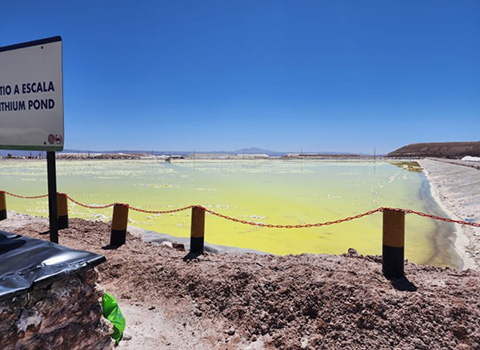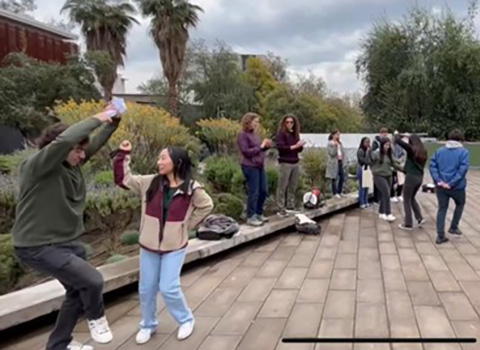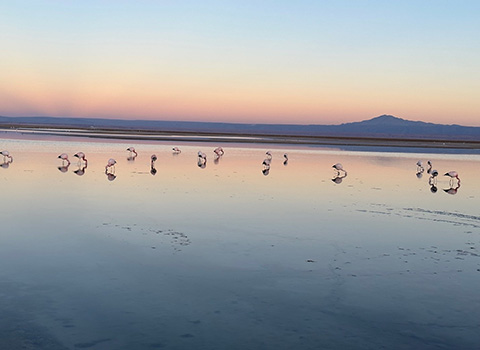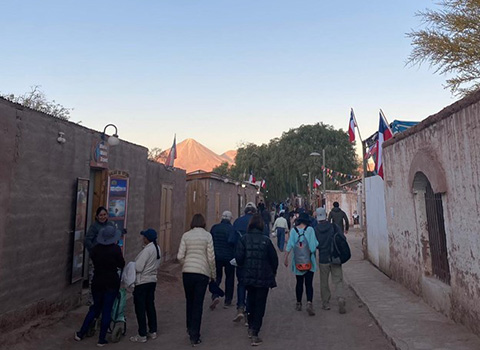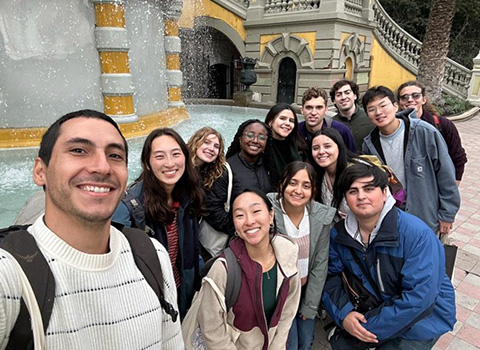Global Engineering Trek North America: Energy Storage & Critical Minerals
CESR launched its third Global Engineering Trek in Energy Storage & Critical Minerals on June 14th, 2025, shifting focus to sites in Montana and Alaska. Follow along below as our seven Northwestern and Montana Tech participants meet with mining and policy experts, tour facilities, and experience the natural beauty of the states they visited.
This program was supported by NSF Grant 2330041 SuReMiNin, CESR, and Montana Technological University. Prof. Jeffrey Richards and Halle Cogley served as Trek leads.
The Global Engineering Trek in Energy Storage & Critical Minerals program previously operated programs in Chile in 2023 and 2024. Reflections on all three Treks can be found below.
June 14th, 2025
Esmeralda Swietelsky ‘28, Chemistry and Environmental Science (Northwestern)
Our journey started in the Chicago O’Hare airport bright and early, and after a round of introductions, we took off and landed in Bozeman, Montana. After a brief stop at our hotel to drop off our bags and change into hiking clothes, we drove to downtown Bozeman and ate a delicious brunch at a restaurant called “jam!” We then drove around 45 mins to Hyalite Creek Trail, where we hiked the Grotto Falls Trail, which as the name suggests, features a beautiful waterfall at the end of the trail. One of the other students on the trip, Yoon, and I dipped our feet in the freezing water and then fully committed to crossing the river. Once we got to the other side, we climbed up and around the side of the river and fallen trees to get below an overhang next to the waterfall, enjoying the sound of rushing water and the frigid spray. While Yoon and I braved the water, Ady, Damian, and Sophia continued hiking up right beside the waterfall to get a view down.
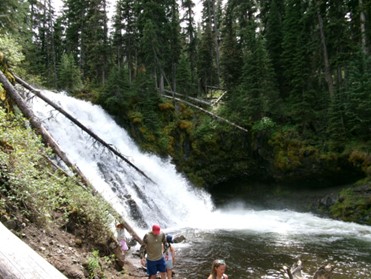

After the hike, we went back to the hotel to freshen up, and then ventured back out into Bozeman to eat dinner at a restaurant called “Revelry.” We ordered family style and shared wonderful plates of pasta and pizza (my favorite dish was the bison bolognese; I mean you HAVE to try bison when in Montana, right?) We then went line dancing at a place called “Bourbon,” which also served as a restaurant. There was a dance instructor who came out every couple of songs to teach the people gathered a new dance, which was incredibly helpful for us, especially as it was the first time line dancing for most of the people in our group.
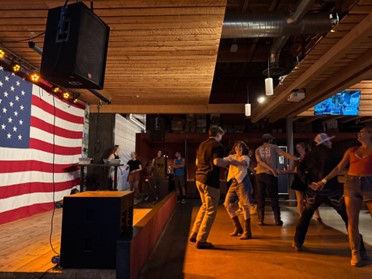
We line-danced the night away, and afterwards went back to the hotel and collapsed in our beds after a tiring but invigorating first day. Day 1 was a lovely introduction to the sights, food, and people of Montana, and we couldn’t wait for the rest of the trip.
June 15th, 2025
Sophia Wagner '27, History & International Studies (Northwestern)
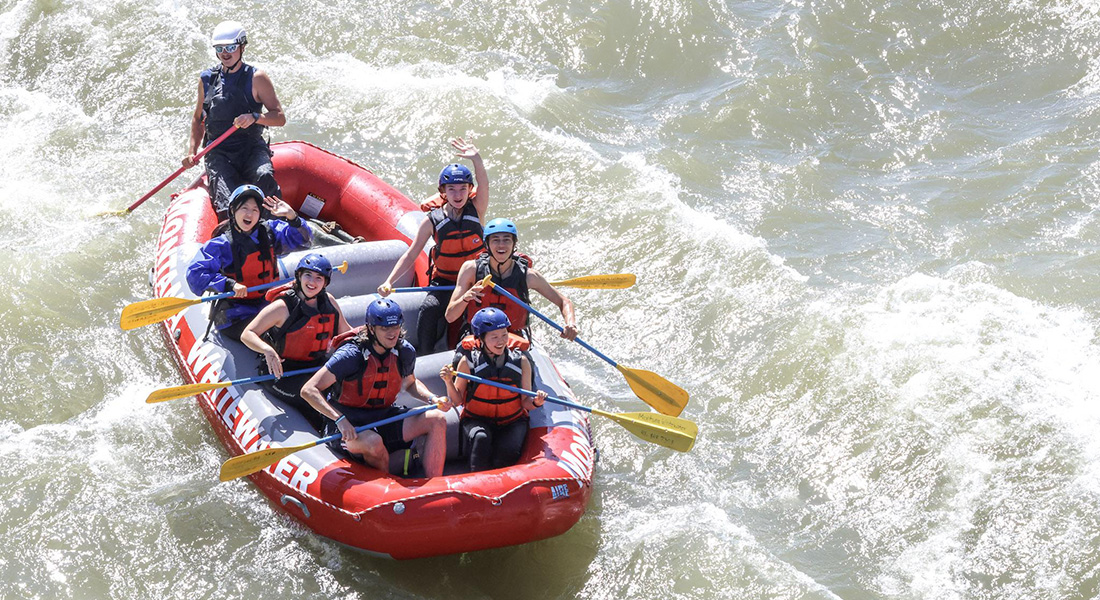
After a super fun first day in Bozeman, we woke up bright and early at 7:15am to drive to over to Gardiner, MT. The hour drive over to Montana Whitewater for our whitewater rafting trip was absolutely stunning; green rolling hills rapidly evolved into piercing, picturesque mountains that lined Yellowstone National Park. As someone who never grew up near mountains, I was stunned at the beauty of the natural landscape. Once we arrived to the rafting place, we got all suited up (quite literally) in wetsuits and water shoes and rode on over to Yellowstone River. Rafting was one of my favorite activities of the trip! Our leader, Jordan, pointed out cool landmarks (the steep “Bacon Monument” and wildlife as we traversed the waves! We stopped for lunch afterwards at the Corral, where everyone tried elk and bison burgers–they were so delicious!
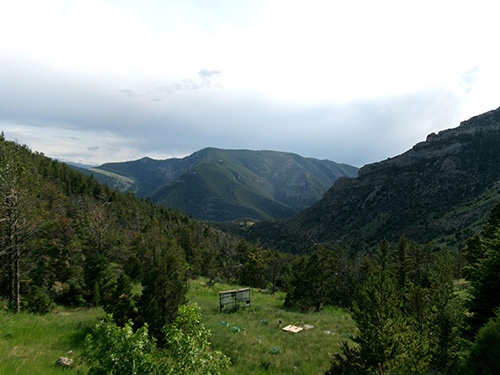
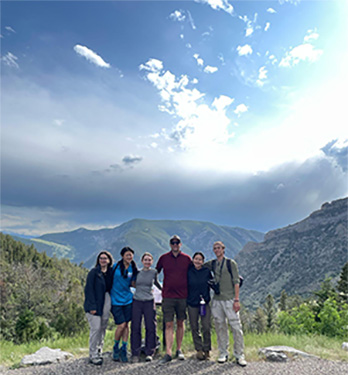
In the second half of our day, we drove over to Lewis and Clark Caverns in Whitehall, MT. Upon walking down the long corridor tunnel to the main cave rooms, I felt the cold change in temperature—somewhere around 55°F inside, while outside was around 75°F. We were told to not touch any of the structures because they grow when water drops from the ceilings of the caves and when the oils from our hands reach the structure, it stops growing. Our tour guide was super engaging and kept cracking puns about the formations we saw in the caves. My favorite shape was of Buddha sitting on a stalagmite formation. From flowing “waterfalls”, delicate popcorn-like textures and towering columns of stalactites and stalagmites, learning about geology was way more fun than I expected.
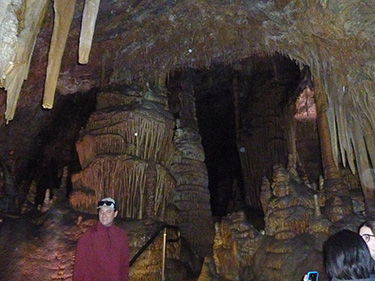
We finished off our day with a trip to Whole Foods for dinner and a snacks run. Funny enough, we ended up munching on the fresh fruit for the next few days until we left Bozeman!
June 16th, 2025
Damian Koliarakis Bridges '27, Civil Engineering (Northwestern)
For our second full day, we met up with Professor Robin Bullock from Montana Tech and explored the Anaconda Superfund Site, which encompasses 300 square miles from Butte to the town of Anaconda. First was Butte, where we saw the Montana Resources copper and molybdenum mine—our first mine of the trip!. Historically, this was connected by train to the Anaconda smelting site.
Situated right outside of (you could even say sitting directly on top of) the town of Butte, the Montana Resources site was absolutely MASSIVE. We got a lovely tour from Environmental Engineer Jeremy Fleege, who showed us the various aspects of the mine.
The active mine site, which was just a small portion of the overall land, felt absolutely HUGE. Not only that but the scale of the machinery was more than anything I’d ever seen–100 foot trucks scooping away at the mountain–it makes you realize just how small we are, and how large our earth is! This was a huge, open pit that we learned was being mined not in a frenzy, but with extremely diligent planning and caution. We learned that mines have ‘lifetimes’ and in order to maintain their lifetime, Montana Resources was going to the necessary levels to maintain profits while also making sure they can have further reserves to extract if and when needed. Not only that, but every part of the process was going towards some larger purpose–for example, the non-ore goes towards their protective dam, which keeps the town safe from any contamination from Montana Resources in case of a flood.
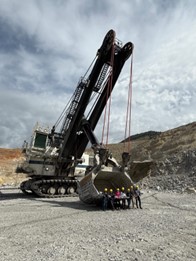
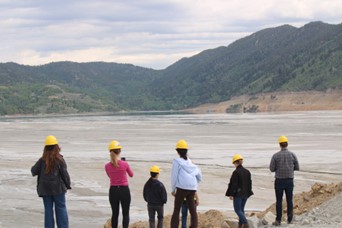
While the non-ore is getting used there, the ore gets processed on site. First, the ore is broken down with steel rods and balls in huge vats. Afterwards it goes through sulfitization. Sulfur gets added into the mix, turning the copper and molybdenum from hydrophilic to hydrophobic. Bubbles pass through the mixture and the copper and molybdenum get pushed up as powder to the top of the water. This then gets sold to traders who will find somebody to smelt it.
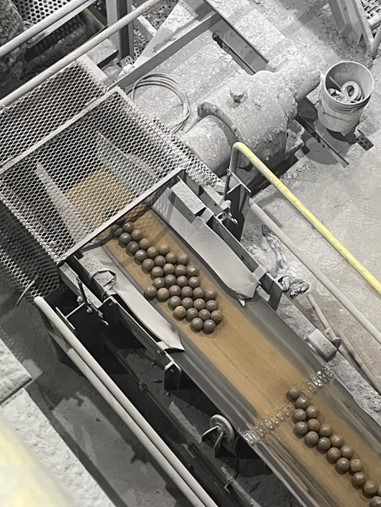
After the steel rods, steel balls are sent into large washing-machine-esque spinning vats to crush up the ore material.
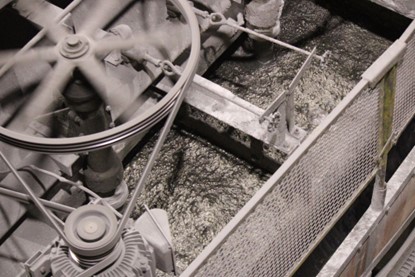
In the sulfitization process to extract ore, bubbles are passed through to bring the copper and molybdenum up to the top of the water, where it is then filtered out with a wall (only the bubbles rise up over the top).
 Nonetheless, something we learned is just as the ore is not the only thing being used at the mine, it is not the only focus of the mines and the mining industry. The processes there generate and have generated a lot of waste, and so there has been a lot of efforts both at Montana Resources and the Anaconda site to come up to code with environmental regulations. At Montana Resources, the Berkeley Pit, where they previously mined, has a very creative way to keep migratory birds off the water–noisemakers! Beyond that, at the Anaconda site, we also saw a lot of completed environmental remediation. The smelting site previously had put heavy metal contamination into the soil, brought sickness to the people nearby, and devastated the local ecology. Now, a large lake with fish, ducks, and birds sit on the previous site where waste was disposed, keeping it trapped underground. The river nearby has been brought back to its glory, and a golf course and trail has been set up on the historic site to bring jobs and commerce to the town. In the tall smoke stack that looks into the sun, the dark black slag (glassy metallic remains from the process of smelting the ore) that lines the golf course, and the informational postings around the Anaconda trails, the town appreciates and remembers its history, but is now coming into a healthier and more environmentally-friendly era.
Nonetheless, something we learned is just as the ore is not the only thing being used at the mine, it is not the only focus of the mines and the mining industry. The processes there generate and have generated a lot of waste, and so there has been a lot of efforts both at Montana Resources and the Anaconda site to come up to code with environmental regulations. At Montana Resources, the Berkeley Pit, where they previously mined, has a very creative way to keep migratory birds off the water–noisemakers! Beyond that, at the Anaconda site, we also saw a lot of completed environmental remediation. The smelting site previously had put heavy metal contamination into the soil, brought sickness to the people nearby, and devastated the local ecology. Now, a large lake with fish, ducks, and birds sit on the previous site where waste was disposed, keeping it trapped underground. The river nearby has been brought back to its glory, and a golf course and trail has been set up on the historic site to bring jobs and commerce to the town. In the tall smoke stack that looks into the sun, the dark black slag (glassy metallic remains from the process of smelting the ore) that lines the golf course, and the informational postings around the Anaconda trails, the town appreciates and remembers its history, but is now coming into a healthier and more environmentally-friendly era.
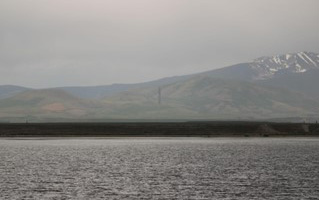


As my first visit to a mine and first time seeing a Superfund site of this scale, this day was truly eye-opening for me. It was amazing to see what we can do remediation-wise when we put our full attention and effort as a country into the well-being of our citizens. As an environmental policy student, it was impactful for me to see the actions that came out of the policies we study in class and as a civil engineer I hope now more than ever to make an impact on our infrastructure in ways that use sustainable materials and work with sources that do things the right way. Looking back on those drives between and around the towns, I definitely miss how beautiful Montana was as well. Not only that, but we had some delicious Irish food in Butte, went to a cool antique store, and had a great day as a team!
June 17th, 2025
Damian Koliarakis Bridges '27, Civil Engineering (Northwestern)
After an early morning drive full of mountain time-lapses, car snacks, and lots of questions from us to Jeff about the highs and lows of chemical engineering professorship, we arrived at the Sibanye-Stillwater Complex, specifically their Columbus Metallurgical Complex. This is where they process metal from their Stillwater Mine, which is the most concentrated platinum and palladium reserve in the world, and also the platinum, palladium, and rhodium from catalytic converters that they receive, allowing them to recycle the precious metals that were put into the converters originally.
To process these metals, they explained the two main processes that they go through: pyrometallurgy, and hydrometallurgy. While nobody got many pictures since we dressed up in full PPE with gloves, we did get to see the whole process and facility which was a super cool experience.
In pyrometallurgy, they heat up the ore in furnaces to take out the moisture which makes slag, which is repurposed for further mineral collection, and matte, which is the heavy metals concentrated as sulfides. When it goes through this process, gases get released that, left unfiltered, would put lots of harmful sulfur dioxide into the atmosphere. Therefore, they have an elaborate (and quite genius) gas cleaning process in place. Sodium hydroxide absorbs the SO2 out of the air and turns it to liquid. Then, the pH and oxidation is adjusted to have sulfates and calcium is put in–the calcium switches places with the sodium that has bonded to the sulfates and you end up with sodium hydroxide once more! The sulfates, now bonded to the calcium, become gypsum, which the complex gives away to farmers for agricultural use.
In their hydrometallurgy process, the nickel matte from the pyrometallurgy is leached (dissolved) via sulfuric acid, agitated, and then the water is burned off so that the nickel crystallizes and remains after. In their process, selenium and tellurium must be filtered out, so this is concentrated and filtered out. The final product, however, reaches electrowinning tanks. These have cathodes and anodes where the final product precipitates in sheets due to the conductive nature.
Not only do they process the metals but they also have a lab where they perform fire assay. Interested companies and mines will send in samples to the complex. They place it in an automated crushing and milling belt to make pellets that are sent for x-ray, from which they can report back what the levels of precious metals are within the sample. This helps mines decide whether a site is worth exploring further, and by proxy helps ensure environmental impacts from mines are for sites that will contribute enough ore for the products they’re used for and the profits of the company.
This visit provided a lot of perspective on the business side of the mining industry. We learned that the Columbus Complex that we are at is one of the only smelters in the US because due to the permitting process that our environmental policy has created, it requires a lot of upfront cost and effort to get a smelter started and permitted. For this reason, a lot of ore processing gets sent for the metallurgy overseas, where law is less stringent but in turn where processes are less environmentally conscious. In the words of the Sibanye-Stillwater engineers, the key to their facility being able to run as one of the only smelters in the United States is very thorough planning, and keeping up with the technologies that go above and beyond–even if it means high upfront costs. Just like Montana Resources, each product and byproduct of their process goes towards some purpose. It was a very thorough tour where we got to see all of their processes and ask lots of questions.
After we got back, we took a lot of the day to chill and have fun together since the next day was our flight to ALASKA! That night we met our Montana Tech counterparts who’d be joining us on the trip. We went out to dinner in Bozeman where I had some bomb chicken and waffles. After a full day we got in for an early night, excited and ready for the days ahead in Alaska.
June 19th, 2025
Kyle Mann '28, Environmental Engineering (Montana Tech)
On June 19th, we had a quick breakfast at our hotel in Anchorage, then hit the road to head to Fairbanks. During our commute, we stopped and got some coffee at a local coffee shop called Jitters, as well as Three Bears Alaska to get some snacks. During the car ride we enjoyed the beautiful views and getting to know each other more.
During the beginning of our time in Denali National Park we stopped at two different lookouts where we could see most of the peaks on the south side of the Alaska Range. We were able to take some photos and enjoy the breathtaking views and see the full height of Denali Peak.
We then went to the visitor's center, where we were able to see the topographic map of the mountain range. Afterwards we hiked over to Horseshoe lake, where we were able to observe a moose and her baby. This was an amazing way to experience and really enjoy the wildlife of Alaska and the beautiful views. We looked at the mountains, the moose, the rocks, the plants and the flowers.
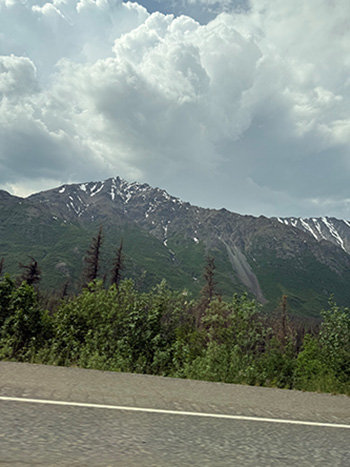
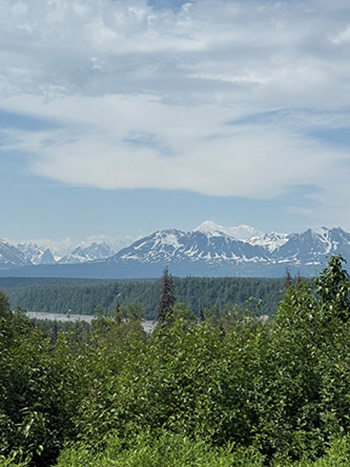
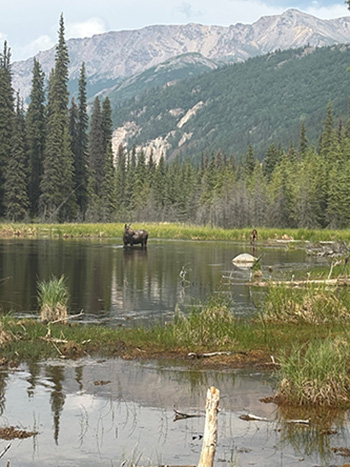
June 20th, 2025
Ady Lam '27, Cognitive Science, Environmental Policy & Culture (Northwestern)
Our day started with a quick visit to the Trans-Alaska Pipeline Viewpoint. Although the main aim of this Trek was to learn about mining and minerals, extensively learning about mining technologies naturally led us to become curious about other energy extraction and transportation technologies. One of the world’s longest oil pipelines, it travels 800 miles from northern to south central Alaska to transport 4% of the United States’ oil production. Much of it is built above ground due to the heat from the oil potentially thawing the permafrost that underlies approximately 85% of Alaskan soil. We also learned that when the pipeline was being constructed, there were workers specifically assigned to bear duty – another example of how the unique Alaskan ecosystem impacts the way energy is extracted!
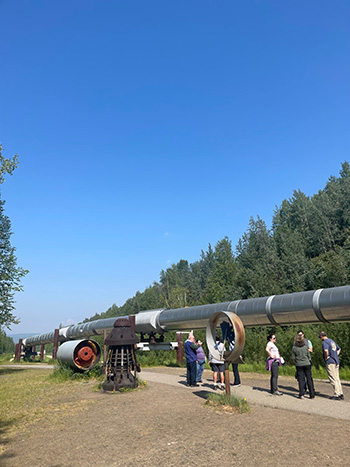
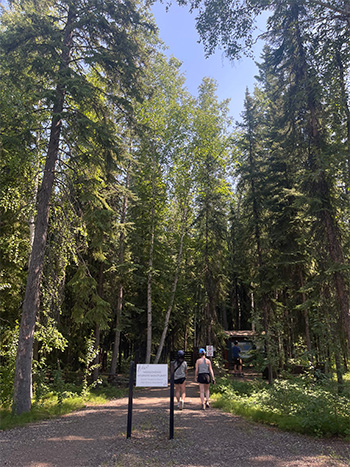

We then had a delicious lunch at a nearby Polynesian restaurant. One of the most enjoyable parts of this trip was admittedly trying a variety of different cuisines, of which there is a regrettable lack of in Butte and Northwestern’s dining halls. Over lunch, we continued a conversation about the differences between Northwestern and Montana Tech; as an international student, my understanding of the ‘American’ experience has invariably been limited to my life at Northwestern and stories from my peers, so getting to hear about the Montana Tech students’ experiences was really fascinating.
Lunch was followed by a visit to the Wedgewood Wildlife Sanctuary, where we enjoyed a walk through the boreal forest and by a large lake. Unfortunately the only wildlife we spotted were the plentiful mosquitoes that never left our side as soon as we entered the ‘sanctuary’. After an hour or so, we returned to the house for some much needed rest – six jam-packed days of travelling and mine visits really takes it out of you! The day ended with a walk in downtown Fairbanks by the Chena River, and dinner at the Pump House Restaurant, a National Historic Site borne from its 1933 pumping station history. Another delectable meal later (I highly recommend the salmon risotto!), and we were done with our seventh day of the trip.
June 21st, 2025
Seoyoon Kwon '27, Mechanical Engineering & Political Science (Northwestern)
We left for the Angel Rocks at around 8AM. The sun was bright as ever, never having had set at all. As we drove down Chena Hot Springs Road, a moose was standing on the side of the road. Jeff slowed down to let it cross, and as we approached, it looked at us and wandered off into the woods. Just when the road seemed clear, another moose hurtled in from the forest on the other side and tripped! It tumbled in a concerningly cartoonish way before nonchalantly striding off after, presumably, its mother. Moose don’t generally travel in groups, but mothers will stay with their calves for a year before splitting off.

We made it to the Chena River State Recreation Area, a grassy parking lot overlooking the beautiful Chena River. After layering on as many rounds of bug spray as we could handle, we set off for the hike, which consisted of a long stretch through the forest along the river, then 900 feet of sharp elevation into giant, jutting rocks. These rock cairns formed millions of years ago when magma was forced upwards towards Earth’s surface, but cooled and did not erupt out of it. Over time, the surrounding earth and rock eroded and exposed the granite core that we call the Angel Rocks. It almost felt disrespectful to just plop down on these geological marvels as we caught our breath and enjoyed the stunning mountains around us.
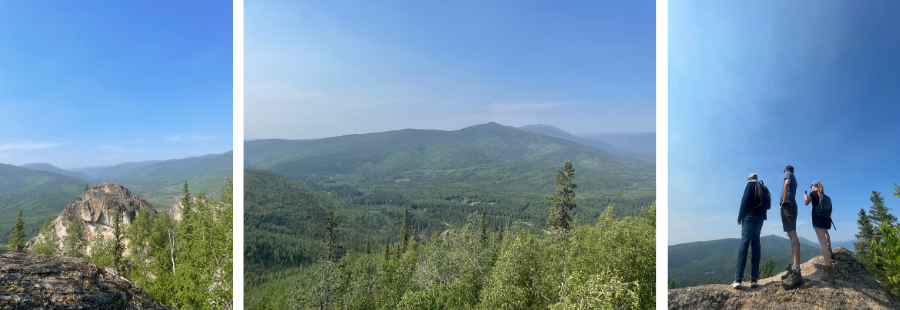 After hustling on the descent to escape the mosquitos (futile), we dipped our feet in the ice-cold water of Chena River then headed back to our North Pole cabin for lunch. We then headed to the Midnight Sun Festival. Though it was about 5:00 PM, the sun was still shining overhead as bright as ever. Another notable feature was the general haziness in the air. This orange-tinged gleam was caused by smoke from the wildfires around Fairbanks and in larger interior Alaska. Though it sounds concerning, especially in a state that is known for glaciers and snow, wildfires are actually a natural part of the Alaskan landscape, and very important to the ecological system. Wildfires clear away the
After hustling on the descent to escape the mosquitos (futile), we dipped our feet in the ice-cold water of Chena River then headed back to our North Pole cabin for lunch. We then headed to the Midnight Sun Festival. Though it was about 5:00 PM, the sun was still shining overhead as bright as ever. Another notable feature was the general haziness in the air. This orange-tinged gleam was caused by smoke from the wildfires around Fairbanks and in larger interior Alaska. Though it sounds concerning, especially in a state that is known for glaciers and snow, wildfires are actually a natural part of the Alaskan landscape, and very important to the ecological system. Wildfires clear away the 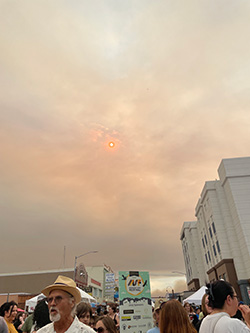 layer of dead and decaying plants and animals, releasing nutrients from that organic matter back into the soil faster than decomposition, opens space for new or small plants to grow, and allows organisms on land or within the soil to access nutrients. Wildfires happen more in the summer due to increased daylight, which dries out plants and therefore provides fires with their ideal fuel, and hotter temperatures, which leads to more atmospheric instability, which in turn causes the thunderstorms and lightning that ignite these wildfires. Tens of thousands of lightning strikes had caused more than 150 documented wildfires all throughout the state so far, including several large ones near Fairbanks. Though wildfires are natural and normal, their size and the frequency and duration of which they happen have been increasing in the recent decades–especially given that Alaska is warming twice as fast compared to the lower 48.
layer of dead and decaying plants and animals, releasing nutrients from that organic matter back into the soil faster than decomposition, opens space for new or small plants to grow, and allows organisms on land or within the soil to access nutrients. Wildfires happen more in the summer due to increased daylight, which dries out plants and therefore provides fires with their ideal fuel, and hotter temperatures, which leads to more atmospheric instability, which in turn causes the thunderstorms and lightning that ignite these wildfires. Tens of thousands of lightning strikes had caused more than 150 documented wildfires all throughout the state so far, including several large ones near Fairbanks. Though wildfires are natural and normal, their size and the frequency and duration of which they happen have been increasing in the recent decades–especially given that Alaska is warming twice as fast compared to the lower 48.
The Midnight Sun Festival, or the Fairbanks Summer Solstice Festival, occurs from noon to midnight once a year and marks the longest day of the year. In Fairbanks, that means the full 24 hours. The festival included live performances, a whole parking lot of food trucks, local shopping vendors carrying anything from Alaskan salmon dog treats to jewelry to knives to paintings of wildlife. We explored and ate at an amazing Thai restaurant, among several on the same block (Somewhat surprisingly, Fairbanks has the largest number of Thai restaurants per capita in Alaska. An uptick of Thai immigration in the 1980s, driven by the 20th century gold rush, grew into a strong Thai community and food scene). We headed home around 10PM, though it hardly felt like evening with the sun still shining.

June 22nd, 2025
Seoyoon Kwon '27, Mechanical Engineering & Political Science (Northwestern)
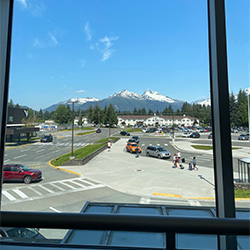 Thanks to the blackout curtains in the cabins, we managed a solid three hours of sleep before our flight to Juneau. After a brief layover in Anchorage, we arrived in Juneau International Airport, where mountain views–McGinnis and Stroller White–promptly greeted us through the airport windows. Sorry, O’Hare, you’ve been outclassed.
Thanks to the blackout curtains in the cabins, we managed a solid three hours of sleep before our flight to Juneau. After a brief layover in Anchorage, we arrived in Juneau International Airport, where mountain views–McGinnis and Stroller White–promptly greeted us through the airport windows. Sorry, O’Hare, you’ve been outclassed.
The sights of the day were the Mendenhall Glaciers. It had been fairly warm in Mendenhall Valley, where we were staying, but the short drive to the Mendenhall Glacier Visitor Center brought a noticeable drop in temperature. As we soon learned, cold air moves down the glacier's surface and makes the area about generally ten degrees colder than just five miles down the valley. A visitor information kiosk read, “People who live near the glacier during the winter may shovel 50% more snow from their driveways than people who live near the airport.” To waste no time shivering, we trekked the mile-long trail to Nugget Falls and, well, the photos speak for themselves.

The Nugget Falls are fed by Nugget Creek, which is the meltwater off of Nugget Glacier–another glacier about five miles away on the mountainside. We sat on some rocks surrounding the waterfall and took a moment to absorb and appreciate the beauty around us. Here, we got a much closer look at McGinnis and Stroller White, as well as Bullard Mountain, which homes the waterfall. Centuries ago, before the Mendenhall Glacier receded to what we see today, Nugget Falls once cascaded directly onto its icy surface. Since 1500, Mendenhall Glacier has retreated more than 2.5 miles. This is evident along the “trimline,” which visually separates the vegetated slopes above from the recently-exposed, barren rock below, where an ecosystem has yet to form.
Now, Nugget Falls goes directly into the lake, adding to its deposits of glacial silt, or “rock flour.” Glacial silt is essentially very fine particles of rock, pulverized by the glacier grinding them against the underlying bedrock. The particles are small enough to remain suspended in the water rather than settling to the bottom. As a result, it gives glacial lakes their characteristic milky look, as well as their color–typically cloudy gray or vivid turquoise.

June 23rd, 2025
Sadie Elmore '27, Environmental Engineering (Montana Tech)
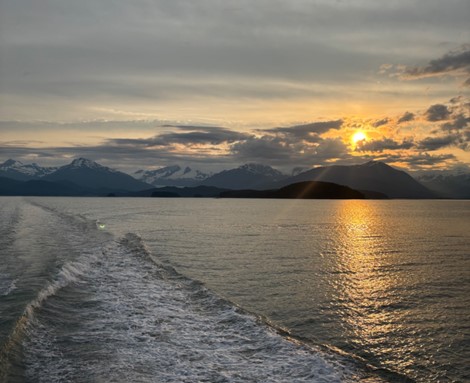 On Monday, June 23rd the group hopped on a ferry boat early in the morning to head to the Greens Creek Silver Mine outside of Juneau on Admiralty Island. The group enjoyed the stunning mountain view’s and the chill from the ocean, which was much appreciated after experiencing Alaska’s first heat advisory in full fledge. While most of the crew members stayed in the shelter of the cabin, it was interesting to experience the commute of the employees.
On Monday, June 23rd the group hopped on a ferry boat early in the morning to head to the Greens Creek Silver Mine outside of Juneau on Admiralty Island. The group enjoyed the stunning mountain view’s and the chill from the ocean, which was much appreciated after experiencing Alaska’s first heat advisory in full fledge. While most of the crew members stayed in the shelter of the cabin, it was interesting to experience the commute of the employees.
We started the tour with a breakfast provided by Hecla, a safety video, then headed to the underground portion of the tour where we were able to watch as they put up mats. Mats are a wire style infrastructure used to stabilize the ceiling and walls of the underground tunnels, so there is no debris that comes loose, which eliminates gravity hazards in that sense.
We were also able to witness the miners as they drilled holes into the rock, where explosives will be put in the near future in order to follow an ore deposit that the geological team has deemed worth exploring. We learned that the procedure they use to ensure there are no employees underground when the explosives are employed. We also were able to experience a Refuge Chamber, as well as have some insight into the standard procedures in the chambers depending on the emergency.
After the underground portion of our tour, we were able to see the Mill, where the ore is processed to produce a more concentrated product. We learned about each step in the process, including the tumblers, the bubblers and more. We also got to see the control room, see the system used to monitor the processes as well as meet an intern working at the Mill, who is studying metallurgical engineering at Montana Tech.
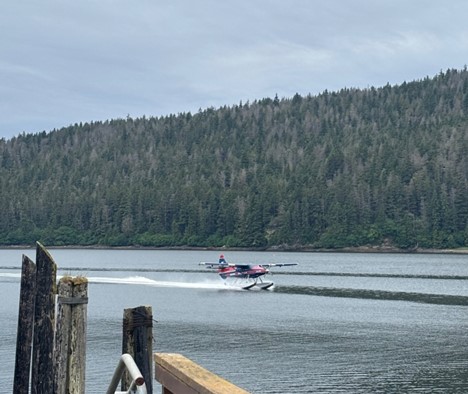 Afterwards, we got to the above ground vehicle maintenance area. We then headed over to the Waste Water Treatment Facility, where we learned about the way the metals and sediment are extracted from the water both chemically and physically. We not only got to see the vats where the process takes place, but also the computer system used to monitor each part of the system to ensure the process is running correctly and efficiently. Finally we were able to learn about the processes used to ensure no contamination takes place from the tailings, using soil coverings, linings, external sources and more.
Afterwards, we got to the above ground vehicle maintenance area. We then headed over to the Waste Water Treatment Facility, where we learned about the way the metals and sediment are extracted from the water both chemically and physically. We not only got to see the vats where the process takes place, but also the computer system used to monitor each part of the system to ensure the process is running correctly and efficiently. Finally we were able to learn about the processes used to ensure no contamination takes place from the tailings, using soil coverings, linings, external sources and more.
To finish off the day, we had the opportunity to ride in a float plane on the way back to Juneau, which was a unique and memorable experience for everyone.
June 24th, 2025
Esmeralda Swietelsky ‘28, Chemistry and Environmental Science (Northwestern)
We began our last day of the trip with a hike at the Gold Creek Flume Trail. After enjoying the absolutely gorgeous views on the hike and taking many, many, photos, we took a shortcut down the side of the mountain (on what may have very well been a closed trail) to leave the forest and head into the heart of downtown Juneau.
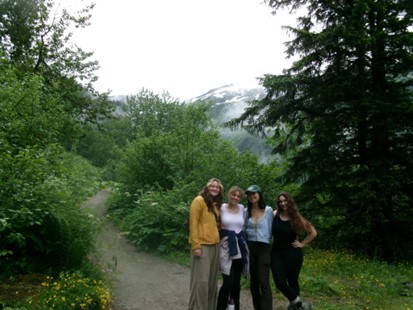
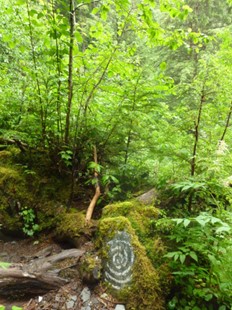
We ate lunch at a restaurant called “V’s Cellar” where we sadly said our goodbyes to the Montana Tech students as they departed to the airport to fly back home to Montana. After lunch, we decided to explore the local shops in Juneau as we had a couple hours before our flight. What began as entering a store to pet the kittens spotted through the window, turned into a lovely conversation with Lily Hope, a Tlingit Alaska Native, about her practice as a Chilkat and Ravenstail Weaver and her store (Wooshkindein Da.aat Lily Hope Weaver Studio). The majority of Lily’s work is creating ceremonial dance regalia, such as Chilkat dancing robes, which takes roughly 2,000-4,000 hours to complete. We showered her with many questions, and she showed us a video of her harvesting the cedar bark herself that she uses to thigh spin into yarn. Lily then graciously offered us incredibly discounted tickets for the Goldbelt Tram, a tramway/gondola that brings people up Mt. Roberts and is owned and operated by a local Native corporation, Goldbelt Heritage Foundation, which Lily Hope is a shareholder of.
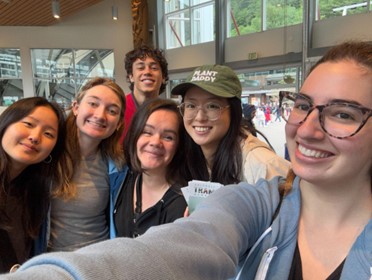
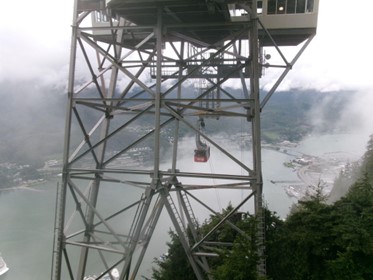
We gratefully accepted, and took the tram up the mountain. At the top, we explored the giftshop and surrounding buildings and found a friend and pupil of Lily, Rae Mills (@ shaawatge on Instagram), who was doing a live demonstration of Chilkat weaving for the public.
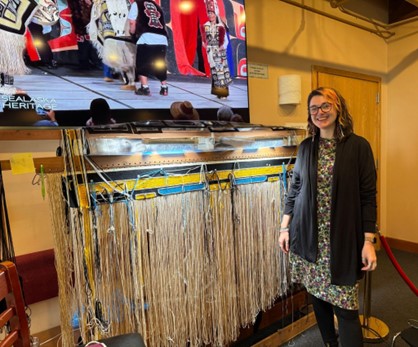
We were all struck by how a simple conversation turned into an unexpected connection and deeply impactful experience. Big thank you to Lily Hope for being so generous to a group of random kids (follow her @ lilyhopeweaver), and if you’re ever in Juneau, check out her store!
Ady and I went back down the tram to do some last minute exploring of more Juneau shops, while Damian, Yoon, and Sophia stayed up on the mountain for a little longer to do one last hike. After about an hour, we all met back up to head to the airport. After a strange evacuation of the Juneau airport that only lasted 5 minutes, we eventually got settled at our gate, and started our overnight flight back home. Finally, we arrived back in Chicago O’Hare around 6:30 am. As our group was exiting the airport, we spied the gate where we had first departed from Chicago to Bozeman what felt like lifetimes ago (only 10 days). We took one last group photo in front of the gate, and said our goodbyes. Huge thank you and shout out to the best trip leader ever, Professor Jeffrey Richards, for keeping us on track and answering all of our questions genuinely all the time (especially on long drives).

From whitewater rafting on the Yellowstone river, to stunning hikes, to underground mine tours on a remote island in Alaska, this trip was unforgettable and truly amazing. The trip was invaluable, both for the information I learned about mining but also the experiences and people I got to form connections with. Thank you GET North America!
Global Trek in Energy Storage & Critical Minerals, 2024
CESR launched its second Global Engineering Trek in Energy Storage & Critical Minerals on September 9th, 2024, sending a group of 8 students from Northwestern and Montana Tech to Chile. As one of the world's largest lithium and copper producers, Chile is at the heart of global efforts to build green energy generation and storage systems. Follow along below as our students meet with mining and policy experts, tour facilities, and delve into Chilean culture.
This program was supported by NSF Grant 2330041 SuReMiNin, the Paula M. Trienens Institute for Sustainability and Energy, and in part by the Buffett Institute for Global Affairs and CESR.
September 10th, 2024
Katie Cummins '25, Communications Studies
 After a blissful eight hour and fifteen minute flight (blissful for me, seeing as I slept the whole time — others were not so lucky), we arrived in Santiago at the crack of dawn. After passing through immigration and gathering our things, we went straight to our hotel. However, there is no rest for the wicked, so we dropped our bags off in our rooms and pretty much immediately set off for Pontificia Universidad Católica via Santiago’s metro station.
After a blissful eight hour and fifteen minute flight (blissful for me, seeing as I slept the whole time — others were not so lucky), we arrived in Santiago at the crack of dawn. After passing through immigration and gathering our things, we went straight to our hotel. However, there is no rest for the wicked, so we dropped our bags off in our rooms and pretty much immediately set off for Pontificia Universidad Católica via Santiago’s metro station.
PUC (the acronym is pronounced “pook” in Spanish) is one of the largest and oldest universities in Chile, with four campuses located in Santiago. We visited the main one, San Joaquín, and were received by both the internationalization office and a few mining engineering students: Mariel, Miguel, and Carlos. Prof. Javiera Alarcón Laserna led us through an introductory workshop on Latin American culture. Then the students gave us a tour of their labs and Carlos explained his doctoral thesis to us. (As a Communication Studies student who hasn’t been in a lab outside my high school, much of this went over my head. It seemed cool though!) We finished up our time at the university exploring the festivities related to the Chilean day of independence, which included watching a folk dance competition and playing Chile’s version of corn hole.
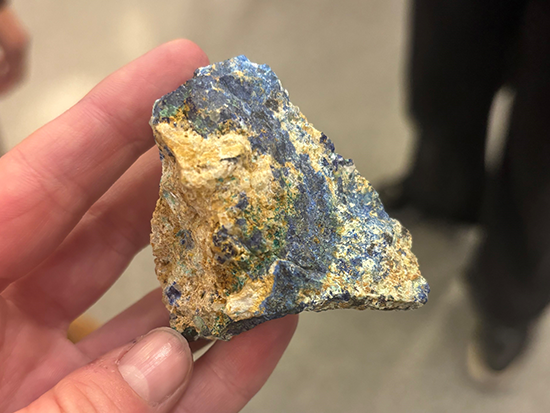 Following our visit at the university, we had the opportunity to visit the AngloAmerican Chile corporate offices, located on the 47th floor of a very fancy skyscraper. There, we were received by Rafael Ascanio, who works on biodiversity assessment, and Gabriella Fuenzalida. They gave us an overview of copper mining, the company, and its sustainability initiatives. The presentation was fascinating. During the presentation, Sr. Fuenzalida said, “We have to do it (mining critical minerals), and we have to do it right.” I think this point of view is critical as we move forward with the energy transition: the acknowledgement that, until we determine some sort of alternative, mining operations such as the ones we are exploring in Chile are imperative and must exist, but they do not have to perpetuate the exploitative socio-ecological history of the industry.
Following our visit at the university, we had the opportunity to visit the AngloAmerican Chile corporate offices, located on the 47th floor of a very fancy skyscraper. There, we were received by Rafael Ascanio, who works on biodiversity assessment, and Gabriella Fuenzalida. They gave us an overview of copper mining, the company, and its sustainability initiatives. The presentation was fascinating. During the presentation, Sr. Fuenzalida said, “We have to do it (mining critical minerals), and we have to do it right.” I think this point of view is critical as we move forward with the energy transition: the acknowledgement that, until we determine some sort of alternative, mining operations such as the ones we are exploring in Chile are imperative and must exist, but they do not have to perpetuate the exploitative socio-ecological history of the industry.
After we finished with the presentation and put the office’s Nespresso machine through the wringer, we went to the mall to exchange our dollars into pesos and grabbed dinner near the Centro Cultural Gabriela Mistral. Then we returned to the hotel and collapsed in our beds, exhausted. All in all, it was a great (and busy!) first day in Chile and I think it set us up nicely for the rest of the trek.
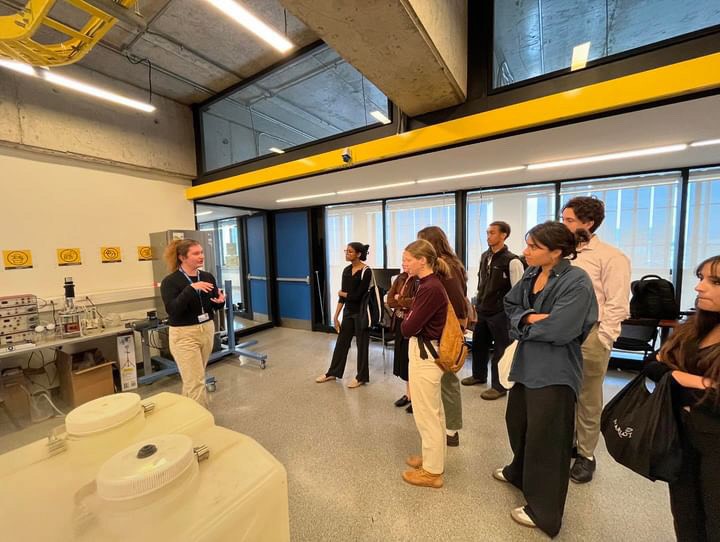
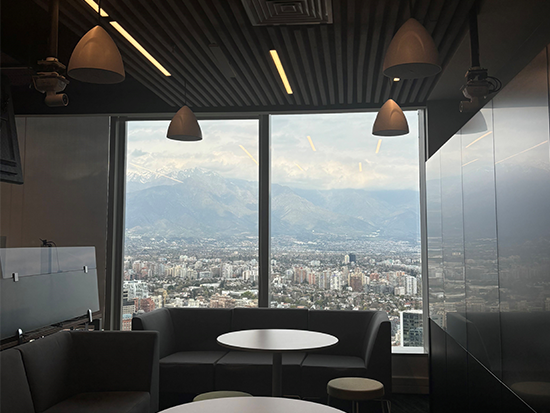
September 11th, 2024
River Shoemake '25, Environmental Engineering (Montana Tech)
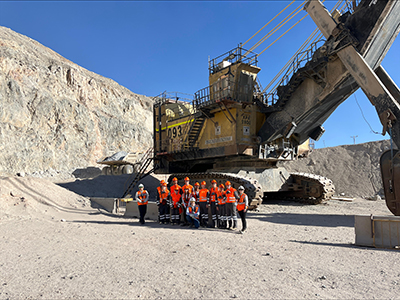 On day two, the trek crew flew from Santiago to Calama to tour Codelco's Chuquicamata copper mine. Chuquicamata lies about 20 km outside the city of Calama and produces a steady supply of low-grade ore that predominantly originates from a sulfide and oxide ore body. Chuquicamata began as an open pit mine but is currently being adapted into an underground mine which will employ a block caving mining method to extract ore. The mine is operated by Chile's national mining company, Codelco, who nationalized the mine in 1971 and took it over from an American mining company, the Anaconda Copper Mining Co. Since taking over, Codelco has continued to adapt to new mining technologies and is now using AI to improve their safety record, among other innovations. Chuquicamata mine has been in operation since 1915, when the pit mine was opened, and has continued to grow and continue to produce since. This has resulted in Chuquicamata being one of the largest copper mines in the world, and one of the top producers as well. The tour included an overview of the mining operations such as a view of the pit, a walk through the concentrator plant, and a journey through the refinery. Witnessing each aspect of the process was equally as impressive as the views from the open pit. At the end of the tour, the crew hopped into a van and drove about an hour and a half to the town of San Pedro, where the next mine tour will take place.
On day two, the trek crew flew from Santiago to Calama to tour Codelco's Chuquicamata copper mine. Chuquicamata lies about 20 km outside the city of Calama and produces a steady supply of low-grade ore that predominantly originates from a sulfide and oxide ore body. Chuquicamata began as an open pit mine but is currently being adapted into an underground mine which will employ a block caving mining method to extract ore. The mine is operated by Chile's national mining company, Codelco, who nationalized the mine in 1971 and took it over from an American mining company, the Anaconda Copper Mining Co. Since taking over, Codelco has continued to adapt to new mining technologies and is now using AI to improve their safety record, among other innovations. Chuquicamata mine has been in operation since 1915, when the pit mine was opened, and has continued to grow and continue to produce since. This has resulted in Chuquicamata being one of the largest copper mines in the world, and one of the top producers as well. The tour included an overview of the mining operations such as a view of the pit, a walk through the concentrator plant, and a journey through the refinery. Witnessing each aspect of the process was equally as impressive as the views from the open pit. At the end of the tour, the crew hopped into a van and drove about an hour and a half to the town of San Pedro, where the next mine tour will take place.
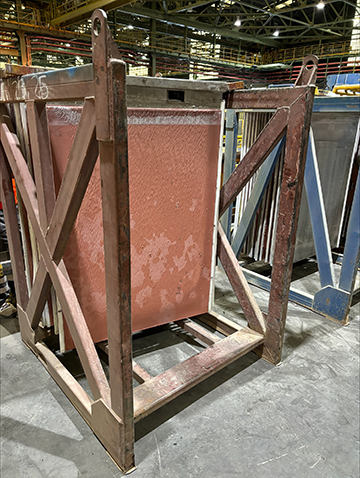

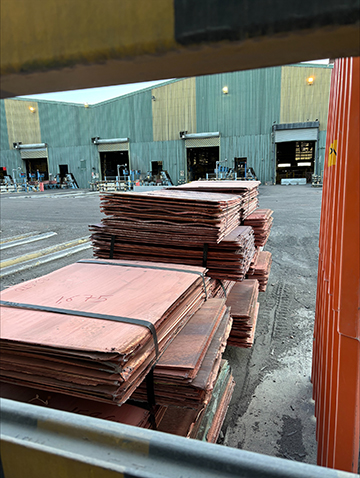
September 12th, 2024
Akeem Griffin '27, Industrial Engineering and Management Sciences
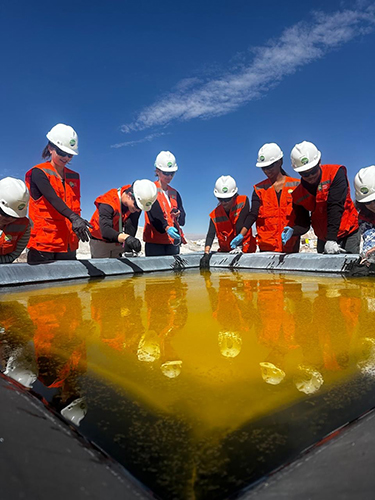 After arriving in San Pedro de Atacama and getting a much needed full night of rest, we woke up and ate breakfast prepared by the hostel. It was today that we would have our long anticipated trip to the Salar de Atacama SQM Lithium extraction facility. The trip to SQM was about two hours long. On arrival, we were greeted by SQM staff and a beautifully prepared spread of snacks.
After arriving in San Pedro de Atacama and getting a much needed full night of rest, we woke up and ate breakfast prepared by the hostel. It was today that we would have our long anticipated trip to the Salar de Atacama SQM Lithium extraction facility. The trip to SQM was about two hours long. On arrival, we were greeted by SQM staff and a beautifully prepared spread of snacks.
We were walked through a presentation highlighting the main operations of the SQM facility. In short, the facility has two products, lithium and potassium, that are extracted via a process relying heavily on evaporation. Large amounts of high lithium concentrated brine is pumped to the surface and directed into pools. These pools are shallow. The idea is that the brine will evaporate, leaving behind non-valuable salts that are heavy in concentration within the brine. Salts like NaCl. What remains after the evaporation process is brine with a higher concentration of lithium. The brine is then directed into another pool, where evaporation takes place again; leaving behind brine with an even higher concentration of lithium. This process is repeated several times until a 6% Lithium concentration solution is created. The solution is then sent to a processing facility where that solution reaches an even higher concentration of lithium. This lithium is sent abroad, mainly to China, to be processed into energy supply products like batteries.
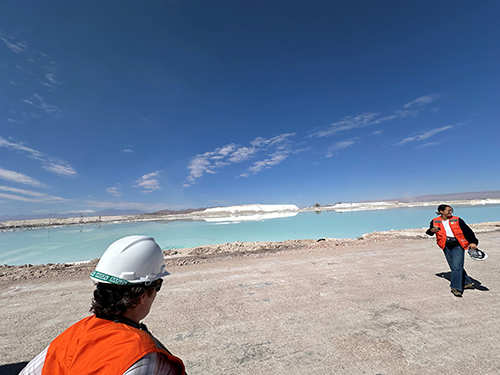 After learning about the general operations process of the facility, we went out to see the lithium pools first hand. Perhaps what stood out almost immediately, and even more than the pools themselves, was the mounds of waste piled up across the facility land. This “waste” is all of the non-valuable salts. It was essentially a land of rolling giant table-salt hills. These salts being an essentially useless by-product of the lithium extraction process left many of us with questions of how we can make those salts useful. We’re still not sure.
After learning about the general operations process of the facility, we went out to see the lithium pools first hand. Perhaps what stood out almost immediately, and even more than the pools themselves, was the mounds of waste piled up across the facility land. This “waste” is all of the non-valuable salts. It was essentially a land of rolling giant table-salt hills. These salts being an essentially useless by-product of the lithium extraction process left many of us with questions of how we can make those salts useful. We’re still not sure.
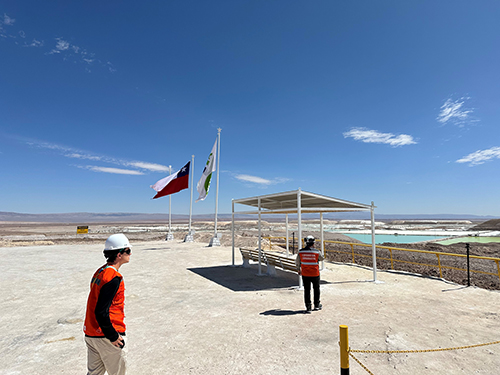 We finished the tour at a viewpoint where we could see the lithium pools in all their glory. From right to left, low-concentration to high-concentration, the pools change color gradually from a turquoise blue to yellow. It was something that I’m sure all of us will remember when we look around and see all of the lithium reliant technology we use our daily lives.
We finished the tour at a viewpoint where we could see the lithium pools in all their glory. From right to left, low-concentration to high-concentration, the pools change color gradually from a turquoise blue to yellow. It was something that I’m sure all of us will remember when we look around and see all of the lithium reliant technology we use our daily lives.
Finally, we returned to our starting point at SQM. We were served a wonderful 4-course meal, obviously well thought out and artistically plated. We were all greatly surprised and enthused, but mostly grateful for the experience. After lunch, we returned to San Pedro de Atacama, where we explored and immersed ourselves in the town until dinner. It was then time for much needed rest before our 6am departure time the next morning.
September 13th, 2024
Halle Cogley '25, Environmental Engineering (Montana Tech)

 On Friday, September 13th, we started the day early to go on a desert ecosystems tour in the Atacama Desert. At 6 am we were picked up at our hostel in San Pedro de Atacama by our tour guide, Ernesto. After picking up a few other tourists, we headed to Laguna Chaxa. This laguna is very special because it's home to three different types of flamingoes: the Andean flamingo, which has a black tail; the Chilean flamingo; and the James flamingo, which is a little smaller. The lithium mine that we had seen the previous day was mentioned because the pumping of the brine from the ground is thought to be affecting the groundwater levels in the area and the lagoon is quickly losing water, affecting the migration of the flamingoes. We got there at sunrise and it was absolutely breathtaking (along with the wind chill). We then went to the Tropic of Capricorn to stop for breakfast. Ernesto and Sammy (our student guide) then made us an amazing breakfast spread with breakfast sandwiches and coffee. We then started our journey up into the Andes to see more lagoons, Miscanti and Miñiques, and volcanoes in the park. We stopped at the two lagunas under the view of the active volcanoes in the area. Then we took off for Piedras Rojas. At this point, some of us were feeling the affects of being at 14,000 feet and we walked slowly out to the Red Rocks Lagoon. The wind was VERY strong and so we stayed long enough to take pictures and enjoy the view and then we walked back. After we piled back in the van, we went to a place put of the wind for lunch, which consisted of a great salad and dessert. We then headed back to San Pedro de Atacama. Once we had rested and showered at the hostel, we headed for dinner at a French cafe nearby and ended the night by walking around the town a little more.
On Friday, September 13th, we started the day early to go on a desert ecosystems tour in the Atacama Desert. At 6 am we were picked up at our hostel in San Pedro de Atacama by our tour guide, Ernesto. After picking up a few other tourists, we headed to Laguna Chaxa. This laguna is very special because it's home to three different types of flamingoes: the Andean flamingo, which has a black tail; the Chilean flamingo; and the James flamingo, which is a little smaller. The lithium mine that we had seen the previous day was mentioned because the pumping of the brine from the ground is thought to be affecting the groundwater levels in the area and the lagoon is quickly losing water, affecting the migration of the flamingoes. We got there at sunrise and it was absolutely breathtaking (along with the wind chill). We then went to the Tropic of Capricorn to stop for breakfast. Ernesto and Sammy (our student guide) then made us an amazing breakfast spread with breakfast sandwiches and coffee. We then started our journey up into the Andes to see more lagoons, Miscanti and Miñiques, and volcanoes in the park. We stopped at the two lagunas under the view of the active volcanoes in the area. Then we took off for Piedras Rojas. At this point, some of us were feeling the affects of being at 14,000 feet and we walked slowly out to the Red Rocks Lagoon. The wind was VERY strong and so we stayed long enough to take pictures and enjoy the view and then we walked back. After we piled back in the van, we went to a place put of the wind for lunch, which consisted of a great salad and dessert. We then headed back to San Pedro de Atacama. Once we had rested and showered at the hostel, we headed for dinner at a French cafe nearby and ended the night by walking around the town a little more.
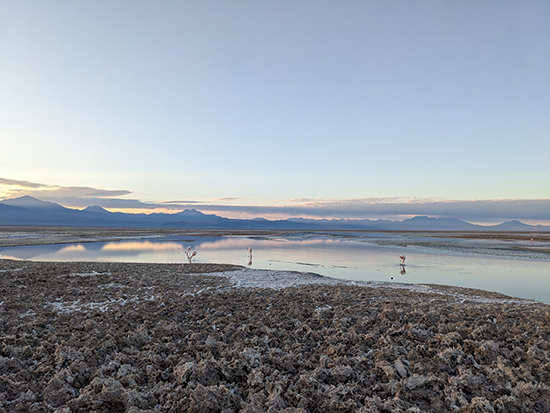

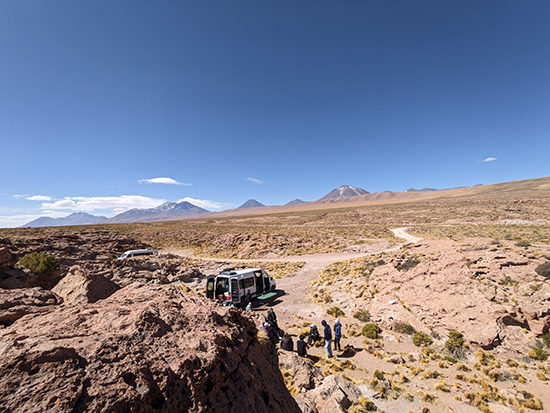

September 14th, 2024
Reem Khalid '26, Computer Science
Today, we traveled from San Pedro to Iquique, a journey that seemed to stretch endlessly through the expansive desert. The landscape shifted subtly as we made our way across the Atacama, the quiet stillness broken only by the occasional cluster of buildings and communities. Though most of the day was spent on the road, our destination was worth the wait—the UC Chile Atacama Station, located within the unique fog oases.
Our precursory-tour of the station was led by Milton, who explained the new research projects and the expanding infrastructure at the site. One of the most interesting aspects was how they’ve developed systems to capture water from the fog using predominantly plastic structures. It was fascinating to think about how this seemingly small-scale process could provide water in a place as dry as the Atacama. Milton’s insights into this technology and the potential it holds for other arid regions really stuck with me, especially given Chile's complex relationship with water due to its mining activities.
Mining is a dominant force here, and you can feel its presence everywhere, from the infrastructure to the people’s livelihoods. As Milton spoke about the research, I kept reflecting on the challenges Chile faces as it tries to balance industrial growth with sustainability. The fog capture system is a small but hopeful example of how innovation can make a difference, even in the most comfortless of environments.
After the tour, we returned to our yurt-like domes for the night, where River and Halle treated us to a delicious dinner. It was the perfect end to a long day of travel, filled with good conversation and reflection on the importance of sustainable solutions in a world increasingly defined by the demands of industry.
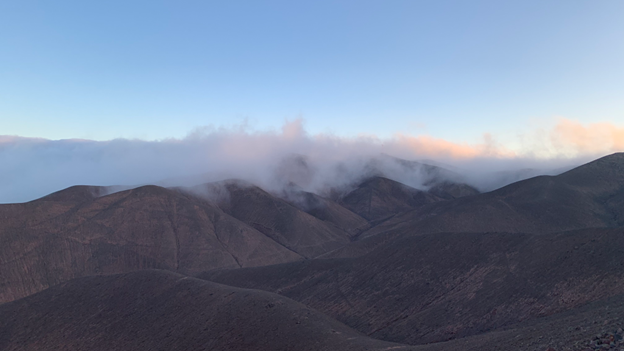

September 15th, 2024
Aidan Boleyn-Fitzgerald '25, Political Science & Environmental Policy
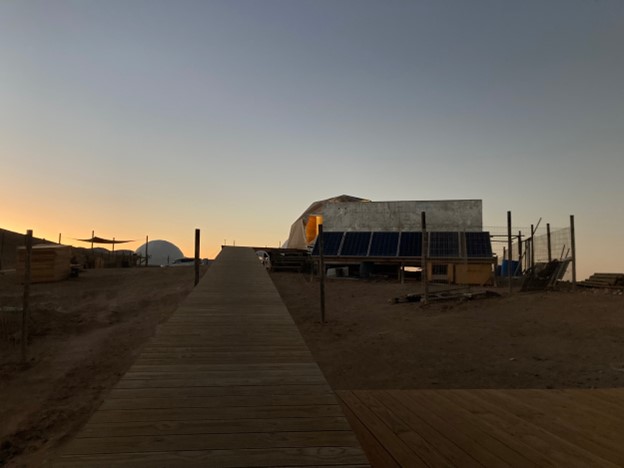
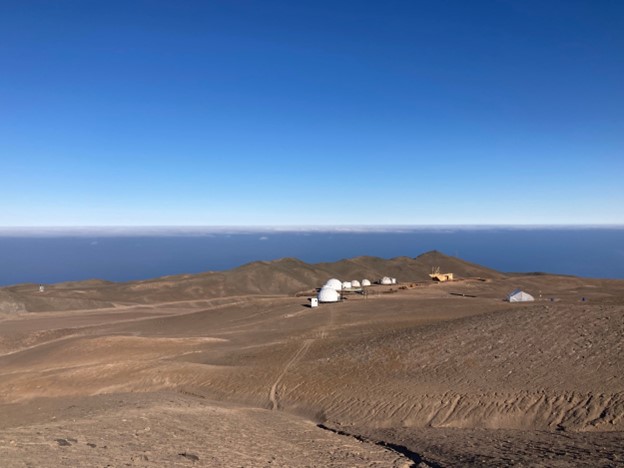
Today I woke up in a dome for the first time. We spent the night at Alto Patache, a PUC research station dedicated to water reclamation research on fog banks. Our guide and station director Milton spends his time at the research station doing his best impression of Matt Damon in the movie Martian, with the benefit of plentiful water and oxygen. On a good day, Alto Patache collects 400 liters of water from the rolling fog using mesh. All of the station’s water needs are met by its fog collectors, including its greenhouse, where Milton grows lettuce and strawberries. Outside, he is developing an irrigation system.
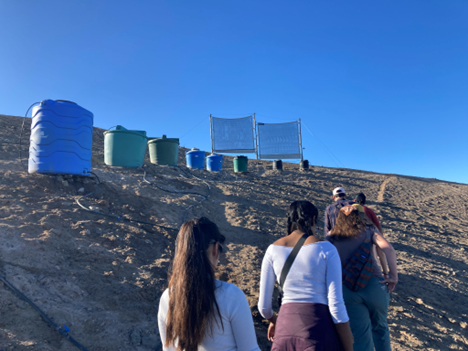

After watching the sun rise, we began the day by preparing and eating a communal breakfast. We then took a three-hour hike around the station. We saw how stones set at 90 degrees serve as natural fog collectors and create an oasis in the desert.
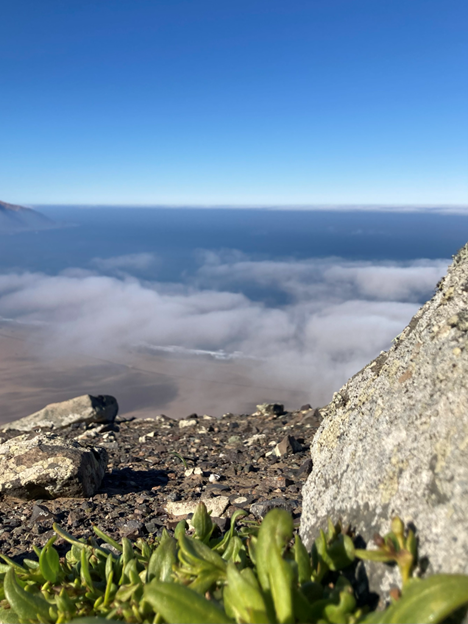
These mountains were covered in vegetation a few thousand years ago. Today, the ecosystem’s base consists of lichen and perennial bulb plants, which lie dormant during the dry season. Rafael counted at least 20 different species in a single stretch of the cliff.
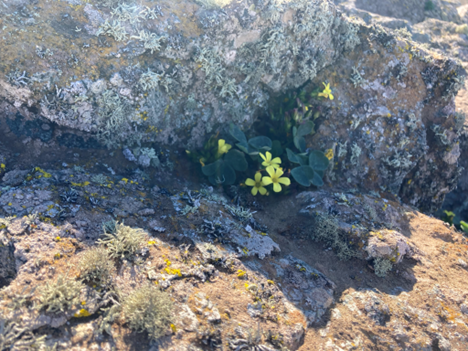
Through various instruments, the station measures seismography, rainfall, humidity, solar radiation, and wind speed and direction. While perfectly dry during our hike, the site experiences significant rainfall and sediment deposits every 10 to 15 years during particularly strong El Niños. The site’s original research station washed away during one of these events.
Our hike was accompanied by an otherworldly view of mountainous desert meeting the coast. Below us was one of two local ports, which ship much of the region’s copper concentrate and cobalt. Most of these minerals are bound for China.
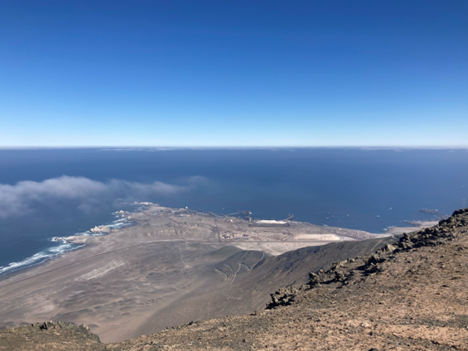
After our tour, we drove down to the ocean. The Humboldt current causes significant upwelling off Chile’s coast, bringing nutrients and thus biodiversity to the ocean’s surface.

After stopping for lunch, Milton showed us ruins of a 4,000-year old fishing village and its graveyard, unearthed during construction of the coastal highway. Milton told us that the ancient villagers likely lived off of fish and shellfish and traded across the Andes.
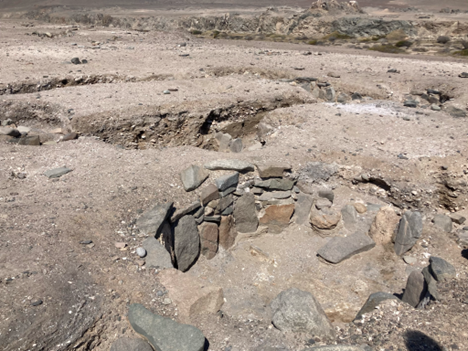
Milton also showed us a 4,000-year old painted rock on the coast.
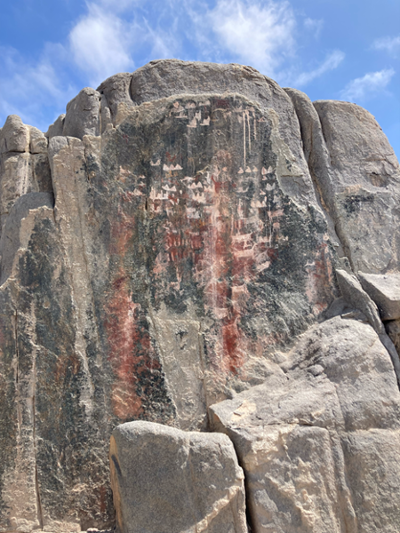
I found it difficult to comprehend how little regulation was placed on archeological sites mere feet from a major highway. We could walk about the ruins and graveyard without supervision or limit to our entry. Historic preservation in the United States feels ironclad by comparison.
Our day ended with a flight back to Santiago. Tomorrow, we will fly to Copiapo and visit the Mantoverde copper mine.
September 16th, 2024
Simone Sullivan '25, Chemical Engineering
Today was a travel day for our third and last mine visit of the trip. We started early this morning in Santiago and after some slight delays, we landed in Copiapo and were on our way to the Manto Verde mine.
 This mine is unique because of its smaller size and newer management system. Manto Verde developed in 1960 in the Antofagasta region, but in 2015 was primarily taken over by Capstone Copper. Francisco, the HR manager of the site, welcomed us and we watched a brief safety video on the site before heading to lunch! It was a cool experience to eat with the mining workers and experience a part of their day-to-day life. On our walk around we got to see the emphasis the management team has put on quality of worker life with the fútbol and multipurpose fields. There are even plans to build a movie theater for weekly activities!
This mine is unique because of its smaller size and newer management system. Manto Verde developed in 1960 in the Antofagasta region, but in 2015 was primarily taken over by Capstone Copper. Francisco, the HR manager of the site, welcomed us and we watched a brief safety video on the site before heading to lunch! It was a cool experience to eat with the mining workers and experience a part of their day-to-day life. On our walk around we got to see the emphasis the management team has put on quality of worker life with the fútbol and multipurpose fields. There are even plans to build a movie theater for weekly activities!
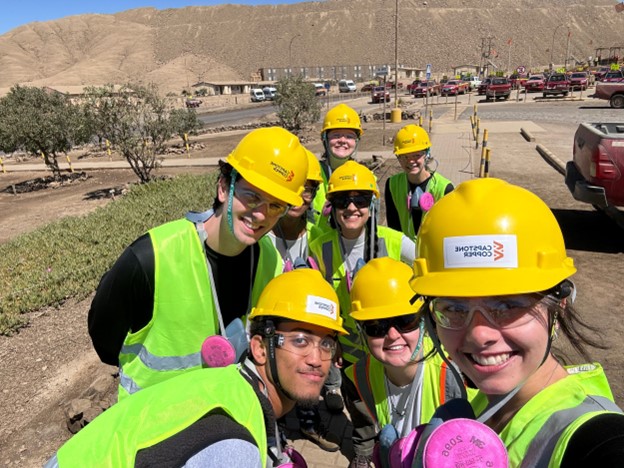 Because of the delays earlier in the day, we had a shortened tour but still got to see a lot. First we visited one of their four open pit mines. They explained their strategy of blasting weekly, as well as the roughly two months it took per layer. The size of the pit was astounding for only being started in January. Next, we got a nice view of the site from a lookout point, and then moved on to tour the operations control room for their sulfide plant. This facility was recently installed, and overall the focus is on optimizing copper production. Before the site could only treat oxides in the SX-EW plant, but now they have the capability of treating sulfides to ship out copper concentrates. It got a little chilly at one point, but overall a sunny site tour!
Because of the delays earlier in the day, we had a shortened tour but still got to see a lot. First we visited one of their four open pit mines. They explained their strategy of blasting weekly, as well as the roughly two months it took per layer. The size of the pit was astounding for only being started in January. Next, we got a nice view of the site from a lookout point, and then moved on to tour the operations control room for their sulfide plant. This facility was recently installed, and overall the focus is on optimizing copper production. Before the site could only treat oxides in the SX-EW plant, but now they have the capability of treating sulfides to ship out copper concentrates. It got a little chilly at one point, but overall a sunny site tour!
We talked a lot today about the importance of women in mining. Lucia, the supervisor of the sulfide plant control center, was a key example of this. She has noticed a large shift in the Chilean mining industry over her past 15 years of experience. There used to not even be women’s bathrooms at sites. Fortunately they are available now, but women at the site are still working towards basic requirements — like sites carrying women’s shoes. Manto Verde has expanded its ratio from roughly 3% to 10% over the past years. Even just walking through the cafeteria at lunch, though, you notice the overwhelming proportion of men. However, we did learn that there is pay equity between genders in the Chilean mining industry.
After our day at the mine, we wrapped up and headed to the airport to fly back to Santiago where we grabbed dinner and caught the sunset.
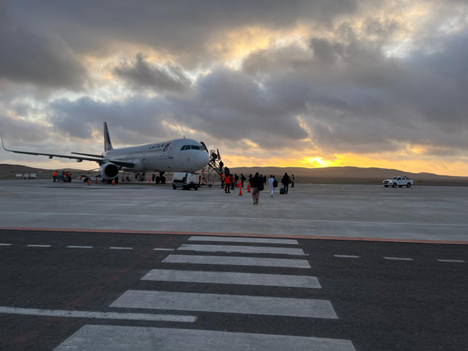
September 17th, 2024
Francia Quirarte '25, Chemical Engineering
Today, our group started the day visiting the Cultural Arts Center. The center held various shops and exhibits with artisanal items handmade by people from various time periods. One such exhibit held items from artists during the era immediately following the coup of September 11th, 1973. Many people were “disappeared” during this time and taken to prison camps where they were tortured and subjected to inhumane conditions. Reading through some of the descriptions, I learned about how the people held in these camps utilized art and craft making as a way to regain their dignity. In this exhibit, there were also more current pieces for sale. In this center, we also saw a community Tai Chi class going on which was quite wholesome.
After visiting this center, we wrapped up our Mining Industry experience here in Chile by visiting the Ministry of Mining. We heard from 3 individuals about their work in both the Copper and Lithium mining industry. This presentation was incredibly informative after having already visited many of the mines they discussed. We were able to hear from government officials’ perspective about the goals they have for the industry as well as some of the challenges they’re currently facing.
We enjoyed a Peruvian lunch after the ministry. After lunch, the group of students ventured on our own to Santa Lucia, a hillside attraction where we boarded a Funicular to reach the top of the hill. From the top we enjoyed gorgeous views of the city as well as the mountains that lay in the distance. Next, we visited Bella Vista Patio to visit the shops within and enjoyed a lively atmosphere when we snacked at one of the restaurants within. We all met up for dinner afterwards and wrapped up the night.
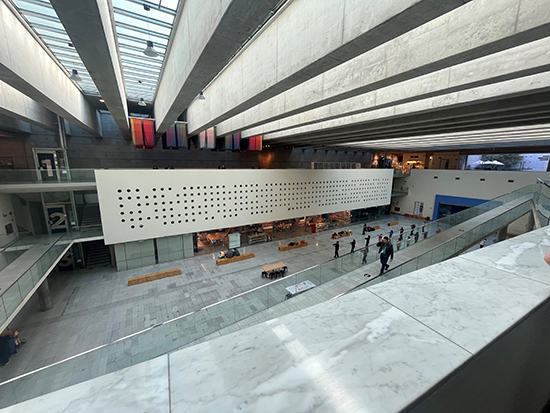
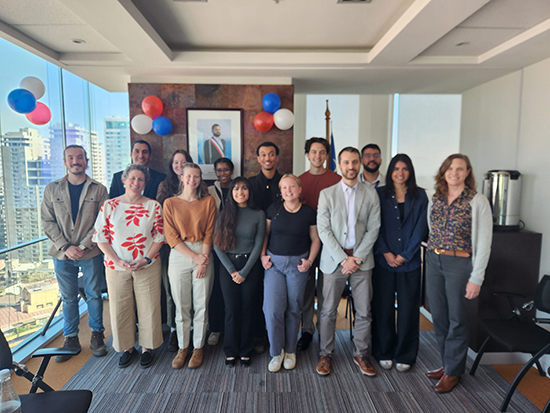
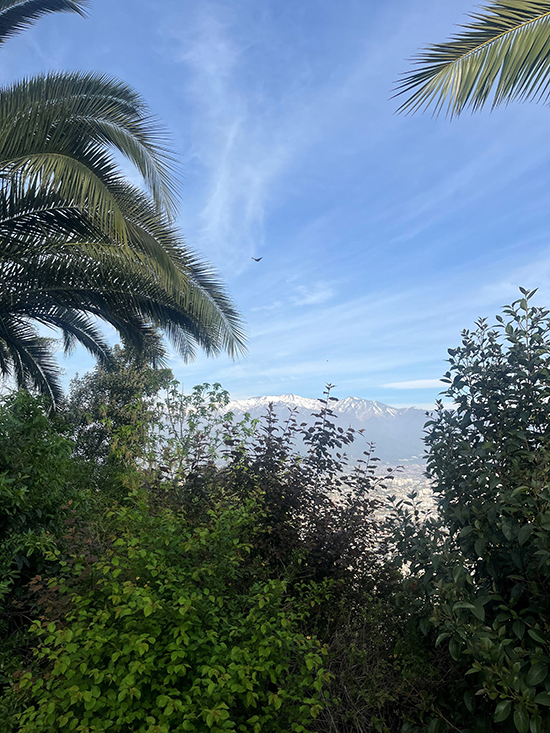

September 18th, 2024
Halle Cogley '25, Environmental Engineering (Montana Tech)
Starting from our hotel in Santiago, we left at 8 am to get to the bus station and departed on our bus to the port town of Valparaiso. On the way, we found out that our tour guide for the day had cancelled on us and so, with Rafael in the lead, we did our own self-guided tour of the city. As soon as we got off the bus, we ran into a Fiestas Patrias parade. After watching some of the parade we went to the artistic part of town. The city is comprised of neighborhoods built on the steep seaside and many of the homes and buildings are bright colors and covered in artistic murals. It was baffling how much of the city was covered in art; there was hardly a wall left untouched. Many of the murals looked very fresh and we noticed that since some of them were political messages, the art stayed up to date with what was going on in the world. Kim noticed that many of the murals included cats and started to document all of them (as seen in the cat collage) with a total of 31 different cats throughout Valparaiso. We walked through a couple different artisan markets, including one in front of the Armada de Chile building. We ate lunch in an awesome restaurant with fresh seafood and continued to walk around the city, taking in the views. Another wrench was thrown in our plans when our bus back to Santiago was cancelled and we had to reschedule to an earlier bus, so we had to take off back to the bus station. After a chilly day of walking around a port town, we all enjoyed the comfortable bus ride back and had dinner in Santiago and called it a night.
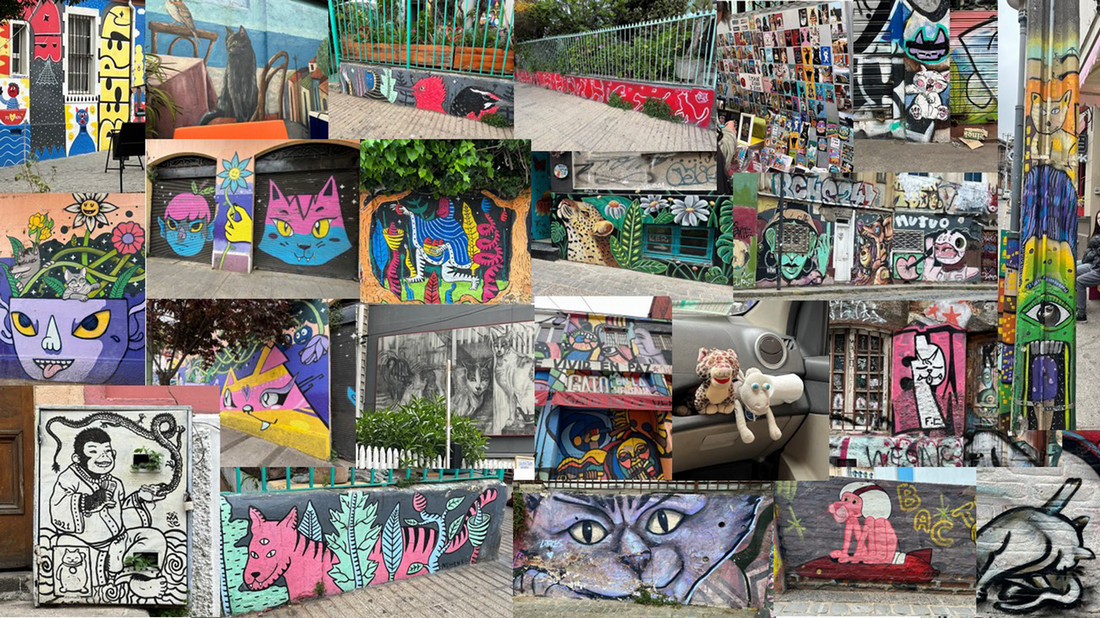
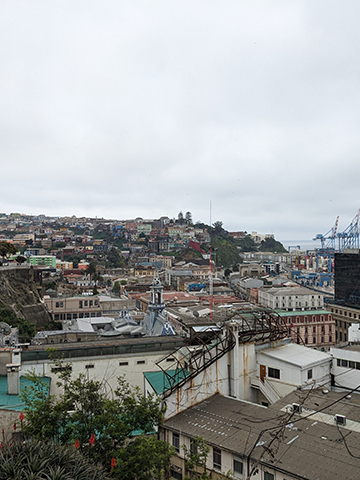
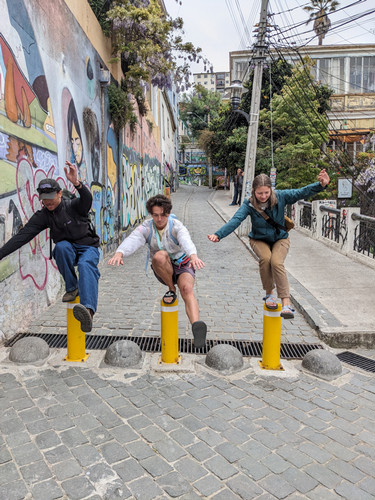
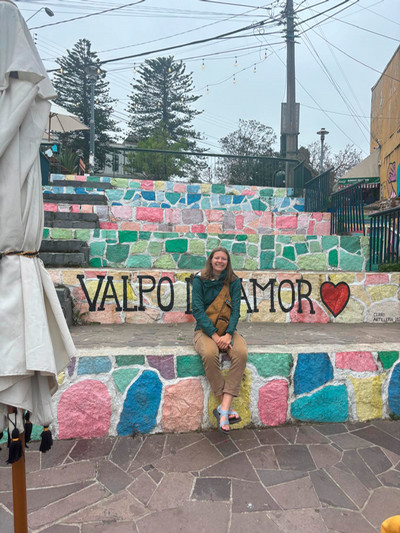
September 19th, 2024
Francia Quirarte '25, Chemical Engineering
 Today, the group went to a traditional Fonda to enjoy the lively festivities of "La Semana de la Chilenidad." This vibrant celebration, which honors Chilean culture and independence, featured a bustling fair filled with typical Chilean food, music, games, and a variety of captivating performances. One of the highlights of the event was the equestrian showcases, where squads from different countries participated in a “Cultural Exchange,” demonstrating both horsemanship and camaraderie. We also had the opportunity to watch traditional Chilean rodeo showcases, which showcased the skill and tradition of the huasos (Chilean cowboys). In addition, there were dynamic dance performances, featuring dances like the Cueca, Chile’s national dance, adding to the festive and cultural atmosphere.
Today, the group went to a traditional Fonda to enjoy the lively festivities of "La Semana de la Chilenidad." This vibrant celebration, which honors Chilean culture and independence, featured a bustling fair filled with typical Chilean food, music, games, and a variety of captivating performances. One of the highlights of the event was the equestrian showcases, where squads from different countries participated in a “Cultural Exchange,” demonstrating both horsemanship and camaraderie. We also had the opportunity to watch traditional Chilean rodeo showcases, which showcased the skill and tradition of the huasos (Chilean cowboys). In addition, there were dynamic dance performances, featuring dances like the Cueca, Chile’s national dance, adding to the festive and cultural atmosphere.
For lunch at the fair, we ate some of Chile’s most beloved dishes, including choripán, a flavorful sausage sandwich, anticuchos, which are grilled meat skewers, and, of course, empanadas, a staple of Chilean cuisine. This was the third day of the week-long "Semana de la Chilenidad" celebration, and the festivities would continue for a few more days.
It was a wonderful experience to be surrounded by the enthusiasm and pride that Chileans have for their Independence Day. The atmosphere was really fun, and it was clear how deeply rooted these traditions are within the community. After spending most of the day at the fair, we returned to the hotel for dinner, reflecting on the richness of Chilean culture and the celebrations that brought it to life.


Reflections
We asked each Trek participant to share their favorite photo from the trip, and a brief description of what it meant to them. Mouse over each photo to learn more.
Akeem Griffin
One of the best parts of this trip was gaining an understanding of an unfamiliar space through exploration and experience. But mostly, I’m grateful for the opportunity to do so with a group so diverse in perspective and skill.

Simone Sullivan
Learn more
Simone Sullivan
This photo was taken on the walk up to the fog reclamation research station on what started off as an unexpected and steep climb up a hill, but turned into one of the most beautiful views I had ever experienced (and one of my favorite parts of the trip).
River Shoemake
My favorite part of the Chile trek was getting to know my peers while learning about Chilean culture and the monumental role that the mining industry in Chile plays in creating a sustainable future.
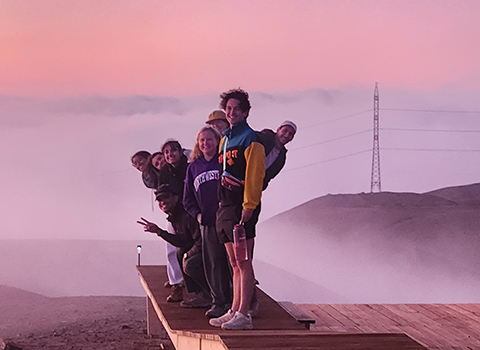
Francia Quirarte
Learn more
Francia Quirarte
This photo was taken at the Fog Capture Research Station, the highlight of my time in Chile, where I experienced the surreal feeling of being among the clouds
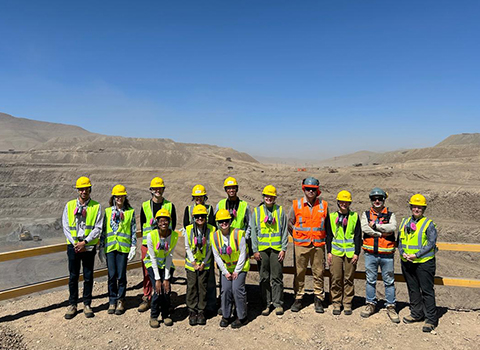
GET Chile 2024
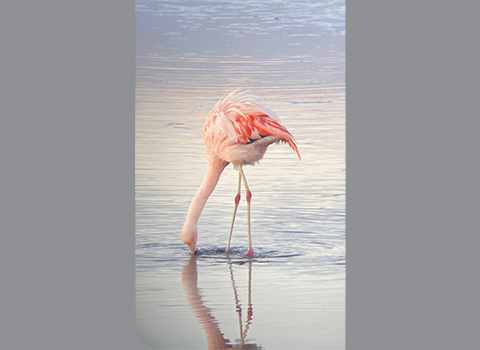
Aidan Boleyn-Fitzgerald
Learn more
Aidan Boleyn-Fitzgerald
I selected this photo because it captures the delicate balance between mitigating climate change and preserving local ecosystems.
Reem Khalid
Mural highlighting corruption in Chile's fishing industry, with companies paying bribes to pass laws in their favor. A meeting point of a fishing village, mining operation, and possible conservation area, symbolizing the clash of economic and environmental interests. These images show how deeply politics, development, and sustainability are intertwined in Chile, with no issue standing alone.
Halle Cogley
This picture stands out to me because it shows so much of the culture in Chile and Santiago, with the equestrian showcase at the Fiestas Patrias event and with the Andes and local vegetation in the background.
Katie Cummins
One of the most incredible parts of my experience in Chile was the opportunity to learn from Chileans (like Milton, pictured) speaking so passionately and knowledgeably about their projects. In this picture, Milton was further explaining the fog reclamation traps.
September 7th, 2023
Professor Jennifer Dunn, Trek Co-Leader
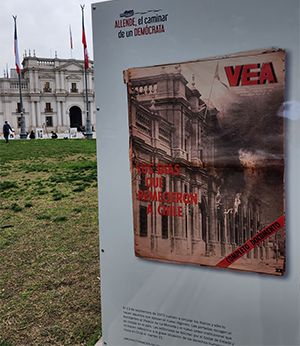
We arrived on Thursday morning in a sunny Santiago. Aside from Rafael Urbana Casanova, a graduate student co-leader joining us on the trip who is Chilean, none of us have ever visited Santiago or Chile before. We were all eager to learn about the city and experience it, so today was all about the city of Santiago. We took a funicular up San Cristóbal Hill and enjoyed views over the city. The views of the Andes mountains were also wonderful. The next stop on our tour was the Plaza de Armas, the historical city center. Finally, we walked to the Palacia de La Moneda which houses presidential offices. We learned about the history of the building and former President Salvador Allende from an outdoor exhibit. In 1973, missiles damaged the building during the coup. The time in Santiago helped us get a feel for the lifestyle and culture of the city. In some ways, with skyscrapers, offices, and shops, the city has similarities to Chicago. Architecture of older, colonial buildings makes some parts of the city feel like Europe. The surrounding Andes mountains connect the city with nature. I think many of us hope to be able to explore Santiago more deeply in the future. After our touring, we enjoyed dinner together and are looking forward to our visit to the Pontificia Universidad Católica de Chile tomorrow.

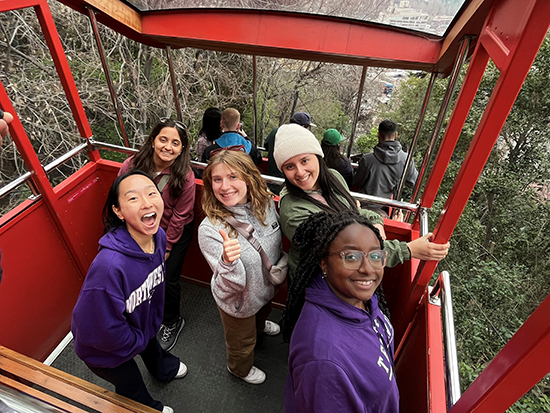
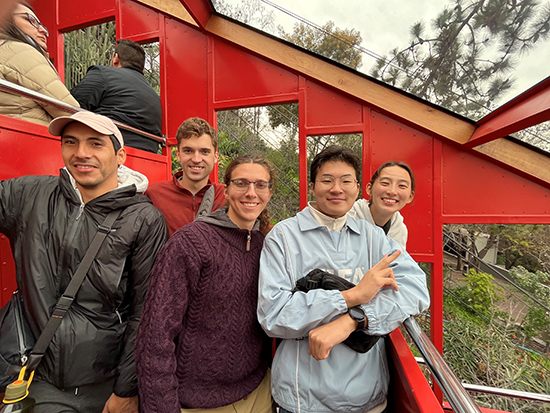
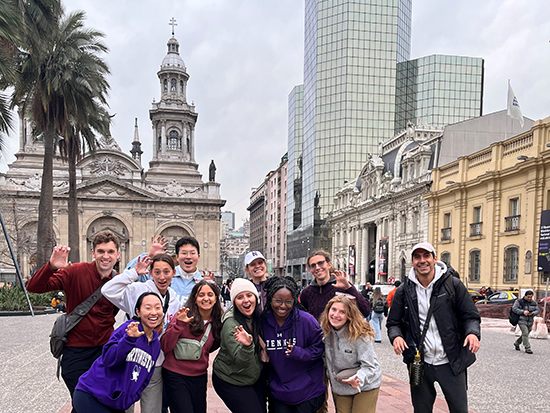
September 8th, 2023
Penelope De La Torre '24, Mechanical Engineering
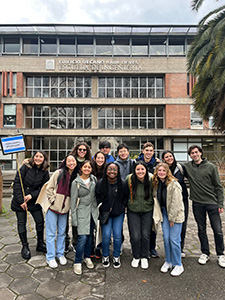 Today, we had a tour of the Pontificia Universidad Católica de Chile (PUC), led by students from the engineering school. It was exciting for us to meet students our age and experience what university life is like abroad. We strolled around the San Joaquín campus and learned a lot about the university's history, the various programs it offers, and some fun bits about school traditions. Our tour concluded at the Mining Engineering department, where we attended a lecture by Professor Alvaro Videla on sustainable mining strategies in Chile. It was interesting to learn about the growing emphasis on transparency and the development of sustainable solutions within Chilean mining companies. Following the lecture, we enjoyed lunch and had the opportunity to connect with other students in the mining engineering department.
Today, we had a tour of the Pontificia Universidad Católica de Chile (PUC), led by students from the engineering school. It was exciting for us to meet students our age and experience what university life is like abroad. We strolled around the San Joaquín campus and learned a lot about the university's history, the various programs it offers, and some fun bits about school traditions. Our tour concluded at the Mining Engineering department, where we attended a lecture by Professor Alvaro Videla on sustainable mining strategies in Chile. It was interesting to learn about the growing emphasis on transparency and the development of sustainable solutions within Chilean mining companies. Following the lecture, we enjoyed lunch and had the opportunity to connect with other students in the mining engineering department.
My favorite part of the day was during the middle of the PUC campus tour. Chile's Independence Day, celebrated on September 18th, kicks off with festivities at the start of the month. While we were 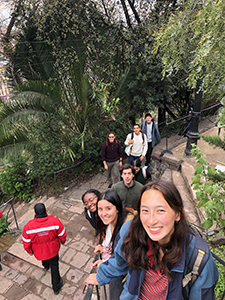 exploring the campus, our tour guides noticed the sound of cueca music being played by some PUC alumni. They kindly demonstrated how the traditional cueca dance is performed and even invited several students from our group to join in and participate in the dance! This was, by far, my favorite part of the day and one of the most memorable moments from the trip. It was a very spontaneous activity that we just happened to come across, but it was really fun to experience it and learn from the PUC students.
exploring the campus, our tour guides noticed the sound of cueca music being played by some PUC alumni. They kindly demonstrated how the traditional cueca dance is performed and even invited several students from our group to join in and participate in the dance! This was, by far, my favorite part of the day and one of the most memorable moments from the trip. It was a very spontaneous activity that we just happened to come across, but it was really fun to experience it and learn from the PUC students.
Following the tour, we walked around Santiago with the PUC guides and made a stop at the Centro Gabriel Mistral. Here, we learned about the history of the coup that had taken place in Chile. Our visit happened to coincide with the 50th anniversary of the event, and as a result, the city was covered in memorials for the event. It was interesting to learn about its impact on the community and see how the country has worked to heal from the event. Finally, we walked up Cerro Santa Lucía to enjoy the panoramic view and neighborhood before parting ways from the PUC students for dinner.
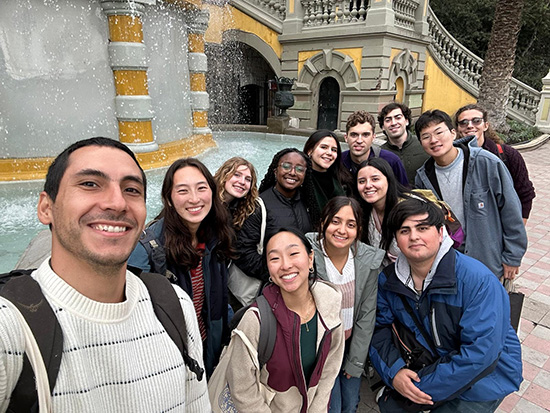
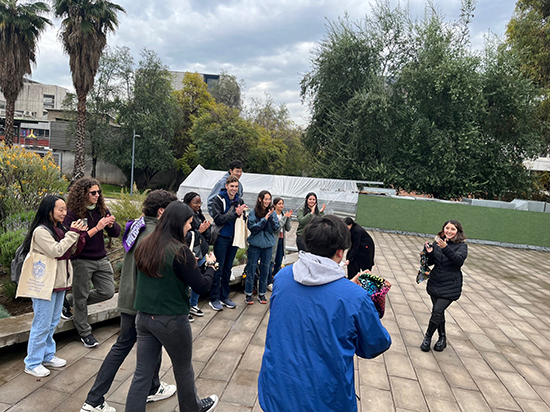
September 9th, 2023
Alicia Malek '26, Integrated Science Program/Economics
 After a late, but exciting night, we woke up early to catch our plane to Calama and San Pedro de Atacama. On the drive to the hostel, we were in awe as we gazed at the incredible view of the mountains. Once we arrived at the Pablito Hostal, we unpacked and prepared for lunch at a cute bakery called Franchuteria. They offered croissants, baguettes, and sandwiches. My personal favorite was a raspberry jelly filled croissant drizzled with white chocolate. Unlike most bakeries, Franchuteria integrated the natural environment with trees surrounding tables which provided a beautiful dining area.
After a late, but exciting night, we woke up early to catch our plane to Calama and San Pedro de Atacama. On the drive to the hostel, we were in awe as we gazed at the incredible view of the mountains. Once we arrived at the Pablito Hostal, we unpacked and prepared for lunch at a cute bakery called Franchuteria. They offered croissants, baguettes, and sandwiches. My personal favorite was a raspberry jelly filled croissant drizzled with white chocolate. Unlike most bakeries, Franchuteria integrated the natural environment with trees surrounding tables which provided a beautiful dining area.
The next couple of hours were spent exploring the town and recharging from the busy days. Later, we had dinner at Diablillo where some of our daring members tried llama and guanaco, a camel-like species living in South America.
As the sun set, we prepared for our Astronomical Tour led by astronomer Alberto Nardin. Wooden platforms with blankets and pillows were set up, and we gazed at the stars above as Nardin used a laser to point out constellations such as Crux, the Alpha Centauri, and Beta Centauri. We also had the chance to better observe the stars with his telescope. My favorite sight was that of Saturn because of the perfect image as if it were a sticker taped on the lense. Nardin also took pictures of us under the stars, and after, we enjoyed drinks and snacks by the bonfire.
We returned to the hostel around midnight and prepared for tomorrow’s daylong expedition.
September 10th, 2023
Katy Meston-Ward '24, Industrial Engineering
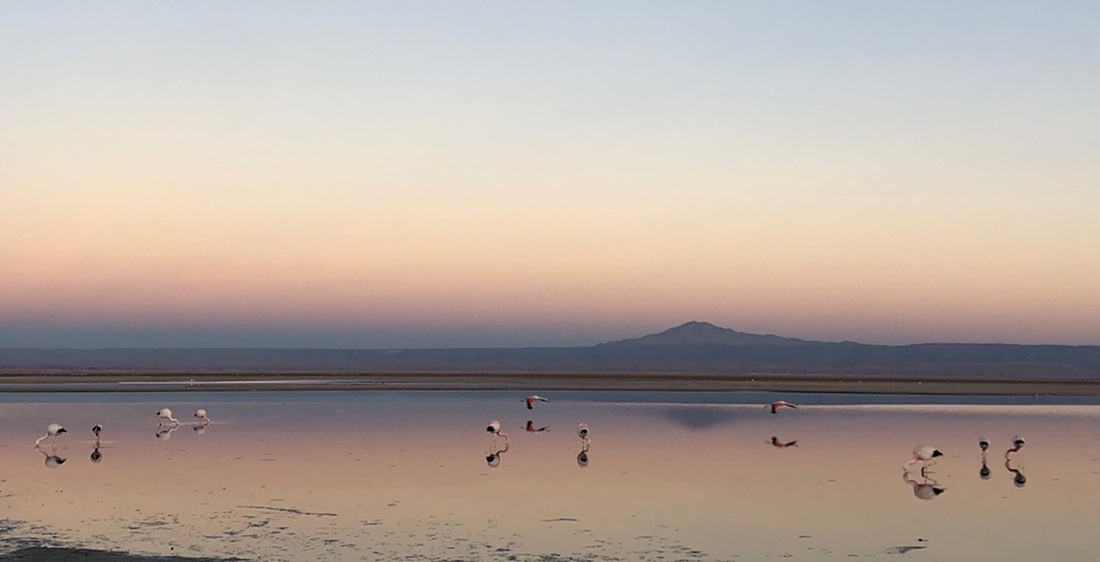
For our second day in San Pedro, we went on a 12 hour excursion into the Atacama desert with an ecotourism guide to learn more about the biodiversity of the desert. We started our day off early, before sunrise, and headed out to the Los Flamencos National Reserve to see flamingos before they left the laguna for day. Of the three flamingo species in Chile, we were able to see two: the Andean flamingo and the Chilean flamingo. Watching the colors of the sunrise reflect in the water and seeing the flamingos so close was such a beautiful sight. After visiting the flamingos, we drove to the Tropic of Capricorn to eat breakfast. By this point the sun had finally risen and we all happy to get warmed up. The breakfast was delicious, made right by our van and drank with maté tea, which is local to the region and helps with altitude sickness. Next, we visited Laguna Chaxa. We were lucky, and there was no wind in the area and the still water of the laguna mirrored the mountains surrounding it. Also, near the laguna we saw a small pack of vicuñas which are similar to llamas. Their numbers have recently grown in the Atacama region after years of being hunted for their soft wool. Our final stop was Red Rocks, a small hike through a rocky region to Salar de Talar, a beautiful light blue water. The day was amazing, and I was shocked by the amount of wildlife throughout the desert. Although it may seem empty, we quickly learned that the Atacama region is rich in life and beauty. I also appreciated that we took the time to understand the ecosystems where lithium mining is taking place.
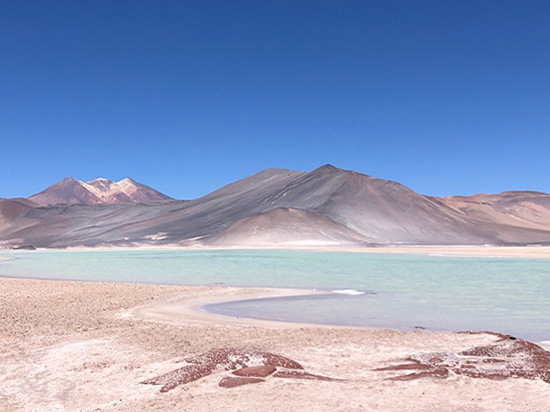
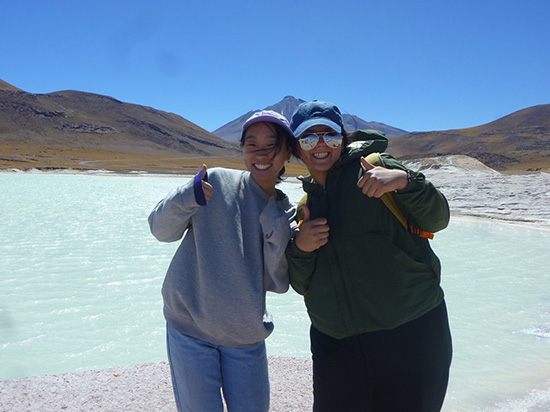
September 11th, 2023
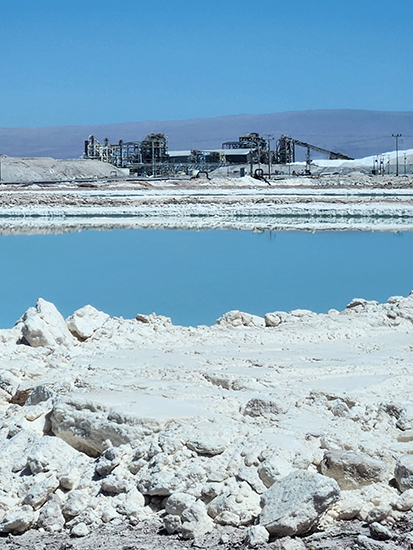 Our day started with breakfast at the hostel, followed by a van ride south from San Pedro to the SQM lithium production facility. The ride took us through small, sparsely populated towns and desert, most of which we had seen during yesterday’s tour. On the final road leading to the SQM facility, we spotted pipelines which we later learned were freshwater supply lines, and, in the distance, massive piles of what appeared to be stark white sand. We were greeted by Ivonne Toro, a community relations director for SQM, and our tour guide, who gave a presentation on the operations and environmental considerations of the facility while we had refreshments. An extensive Q & A session ensued, including questions about the biological and ecological factors that the company tracks, the water usage and byproduct production of the lithium harvesting process, and the about the company’s relationship with local communities.
Our day started with breakfast at the hostel, followed by a van ride south from San Pedro to the SQM lithium production facility. The ride took us through small, sparsely populated towns and desert, most of which we had seen during yesterday’s tour. On the final road leading to the SQM facility, we spotted pipelines which we later learned were freshwater supply lines, and, in the distance, massive piles of what appeared to be stark white sand. We were greeted by Ivonne Toro, a community relations director for SQM, and our tour guide, who gave a presentation on the operations and environmental considerations of the facility while we had refreshments. An extensive Q & A session ensued, including questions about the biological and ecological factors that the company tracks, the water usage and byproduct production of the lithium harvesting process, and the about the company’s relationship with local communities.
The process of lithium extraction at the Salar de Atacama site includes pumping vast quantities of lithium-containing brine to the surface, to be evaporated in large, shallow pools. The evaporation causes non-valuable salts of high concentration including NaCl (table salt) and various magnesium-containing mineral salts to precipitate from the brine, leaving a higher concentration of lithium behind. The brine is then transferred to the next pool, where more mineral salts are precipitated out, leaving, after a series of 5 pools, a 5-6% lithium solution (from the starting concentration of 0.18%). This solution is then delivered by truck 300km to the chemical processing facility, where it is further refined to produce the ~30% lithium that is shipped to refinement facilities abroad, primarily in China, to be fully processed into lithium products, including lubricants, batteries, and pharmaceutical products. A number of important lessons were emphasized to us during the explanation and ensuing tour of the facility, including:
- The brine extracted is not potable for human consumption, and the nucleus of the salar (where the facility and aquifer are located) is, as currently understood, devoid of life. This means the significant water use in the form of brine extraction has no measured negative impact on the surrounding ecosystems or communities.
- The comparatively minimal freshwater usage is necessary, but expected to decrease beyond the already significant decreases with continued R&D.
- Continued R&D is also expected to significantly increase the percent yield of lithium from the raw brine (a number not shared with us), so the company is hoping to decrease brine extraction by nearly 50% over time, even while continuing to increase production.
The group had several main observations from the tour, including the incredible scale of the facility (31 1km by 300m ponds for the first of 5 stages), the apparent disorder of the facility (including tangled piping and extra materials), and the incredible amount of byproduct, mostly sodium and magnesium salts, which is produced (composing nearly every road, surface, and embankment we touched).
The tour concluded with a lunch and further conversation with our guides, before taking the van back to San Pedro for a night of live music in the square for the 50 year memorial of the 1973 coup, shopping from local artisans, and a late dinner.
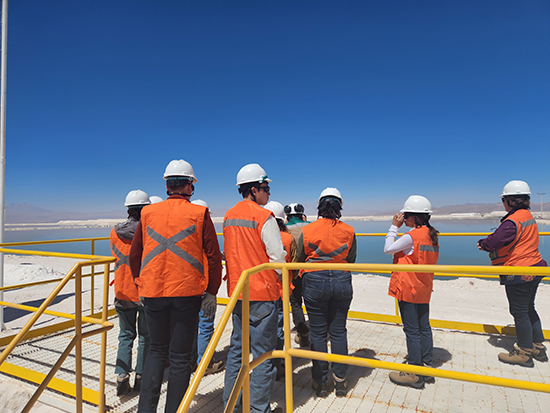

September 13th, 2023
Ella Shin '25, Computer Science
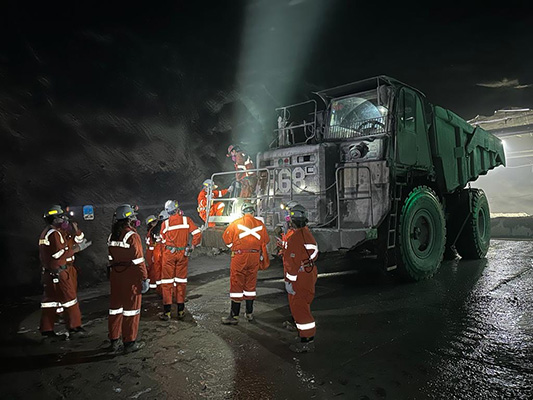 The second day back from San Pedro we started the day by taking the Metro to the Sustainable Mineral Institute, a research institute through the University of Queensland Brisbane focused on researching and supporting the increasing demand for rare minerals through a lens of sustainability and inclusion of indigenous communities. We met with Doug Aitken, the director of the Chilean branch of SMI and a group of other people who worked there, including a mining engineer, a specialist in biodiversity and forestry, a geology engineer, and several people who worked with indigenous communities affected by mining. People on the team were from Scotland, Belgium, England, and Chile and had a range of different career paths and ages.
The second day back from San Pedro we started the day by taking the Metro to the Sustainable Mineral Institute, a research institute through the University of Queensland Brisbane focused on researching and supporting the increasing demand for rare minerals through a lens of sustainability and inclusion of indigenous communities. We met with Doug Aitken, the director of the Chilean branch of SMI and a group of other people who worked there, including a mining engineer, a specialist in biodiversity and forestry, a geology engineer, and several people who worked with indigenous communities affected by mining. People on the team were from Scotland, Belgium, England, and Chile and had a range of different career paths and ages.
They gave us a presentation on different projects they were working on and explained how agreements worked between 21 different indigenous groups and mining companies. They introduced some of the challenges facing sustainability in mining, including the storage of tailings (byproducts in the mining process), water scarcity, and what to do about abandoned mining sites and mine closures.
After the meeting with SMI, we met up with Mikkel, a mining engineering student from Pontificad Universidad Catolica de Chile, to head to El Teniente, a copper mine that is the largest underground mine in the world. It is run by CODELCO, a company that is owned by the Chilean government. It was a beautiful drive up a snowy mountain, where you could occasionally see chutes of grey liquid (tailings from the mine) flowing down the side.
 We arrived and put on safety equipment: bright orange jumpsuits, rubber books, helmets, air masks, gloves, and a GPS tracker. Inside the mountain, we started out by seeing the offices where they control some of the equipment remotely from what look like gaming chairs with joysticks and buttons. Our guide joked about an earthquake happening while we were there, but told us that it would actually be safer to be inside the mine than outside of it there was an earthquake.
We arrived and put on safety equipment: bright orange jumpsuits, rubber books, helmets, air masks, gloves, and a GPS tracker. Inside the mountain, we started out by seeing the offices where they control some of the equipment remotely from what look like gaming chairs with joysticks and buttons. Our guide joked about an earthquake happening while we were there, but told us that it would actually be safer to be inside the mine than outside of it there was an earthquake.
We then went into the actual mines, walking through mud in silent, dark tunnels. We followed our guide through the tunnels, stopping to watch trucks unload piles of rocks. It was unlike anything I had ever experienced before, and unlike some of the office tours and PowerPoint presentations we saw, I felt like I got a real sense of what it is really like to work in the mines, as well as how massive the scale of the operation is. We stopped by the control center on the way back, which was filled with screens that had symbols and words and looked like outdated computer games, and talked about our different reactions to being in the mine.
When we got back to the hotel it had been more than 12 hours since we had left, but we went to meet up with the students we had met from PUC the week before, and we talked about what we had seen on our trip and what Chilean food they suggested we try. Like all the days on the trip, it was packed, exhausting, rewarding, and full of new experiences.
September 14th, 2023
Jun Park '26, Political Science/International Studies
We started off our Thursday morning with a visit to the Human Rights Museum in Santiago, Chile. Chile was under a military dictatorship between 1973 and 1990 under Augusto Pinochet. During that time, many Chilean people were arrested, tortured, or "disappeared." The museum was found under the recommendations of the Truth and Reconciliation Commission and documents the human right violations during the dictatorship. I was impressed by the "arpilleras" which are artworks that express the sorrow and record the oppression. The visit was very emotional and left important lessons for our generation.
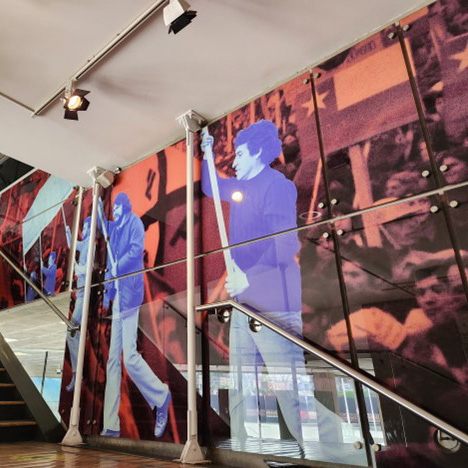
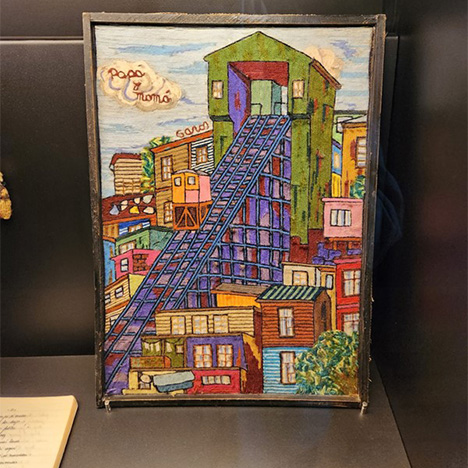
In the afternoon we visited Chile's Ministry of Mining. We were greeted by the chief of staff Jose Inostroza Avaria. We were given 2 presentations on the government policies in mining on copper and lithium. We learned the ministry's attempt to collaborate with the ministry of environment and to diversify the players. We also had a surprise visit from Aurora Williams, the Minister of Mining, who answered many questions. It was a great follow-up of the policy side after our visit to SMI and CODELCO.
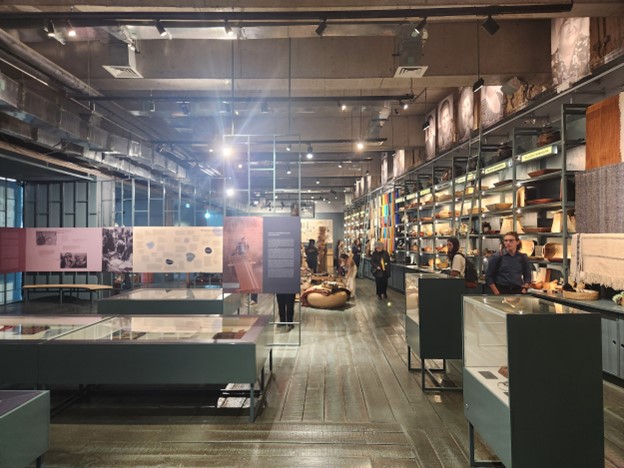
Lastly to end our day, we visited the Centro Cultural La Moneda which had the Fundación Artesanías de Chile. It is a fair trade shop which has artisan craft from local makers and it ensures they get a fair value.
September 15th, 2023
Nathan Rockafellow '24, Mechanical Engineering
 Today, on our final day in Chile, we kicked off the morning by traveling to some local hand-craft shops. There, we walked around the village of shops and were able to appreciate the beauty of the local artisans’ work. It was very cool to see a mix of cultural and local imagery depicted in a variety of mediums, and I appreciated the opportunity to learn more about the country we were visiting.
Today, on our final day in Chile, we kicked off the morning by traveling to some local hand-craft shops. There, we walked around the village of shops and were able to appreciate the beauty of the local artisans’ work. It was very cool to see a mix of cultural and local imagery depicted in a variety of mediums, and I appreciated the opportunity to learn more about the country we were visiting.
Following our cultural excursion, we had lunch and then took the metro to Anglo American, a mining company specializing in the extraction of copper, iron, and nickel. There, Rafael Ascanio, a member of the carbon neutrality and biodiversity management team, gave us a presentation detailing Anglo American’s efforts to study, protect, and preserve the natural environment and climate. The presentation covered topics such as their Mitigation Hierarchy, their Sustainable Mining Plan, their detailed studies of local biodiversity, and their efforts to protect and restore natural environments. I was, frankly, surprised by all the company’s efforts to care for the environment. Typically, when I think of mining companies, I have a stereotypical picture of a company that tears apart the earth without any regard for the environment’s well-being. Anglo American seemed to defy this perception. I was curious to know what was driving them to care for the environment as much as they were. Upon being asked, they replied that modern society demands 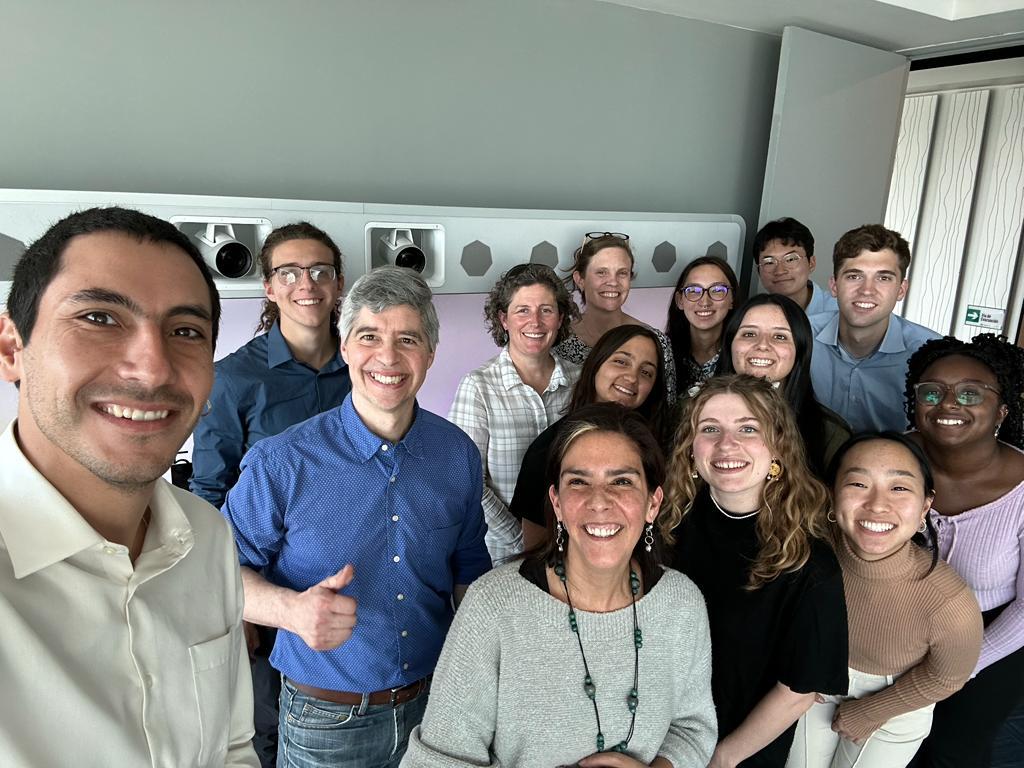 that companies take a more active role in environmental stewardship. It seems Anglo American has embraced this reality in full and is determined to set the gold standard for environmental conservation in the mining industry.
that companies take a more active role in environmental stewardship. It seems Anglo American has embraced this reality in full and is determined to set the gold standard for environmental conservation in the mining industry.
After our Anglo American visit, we returned to the hotel to pick up our luggage and then headed to the airport to begin our long journey back to Chicago. The past nine days have been impactful and insightful in numerous ways, and I think I speak for all of us lucky enough to experience this journey that we are tremendously thankful for all those who have made this trek possible, from those at Northwestern to our partners in Chile. It’s not every day that you get to travel to a country steeped in a history of mining and learn about ways to improve mining sustainability firsthand. We know how lucky we are, and we don’t take it for granted. Thank you!September 19th, 2023
Kalaiya Corbin '26, Psychology/Sociology
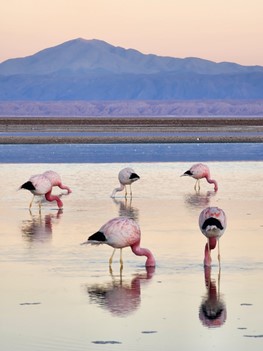 I went on the Global Engineering Trek (GET) to Chile as a Psychology and Sociology student, and I didn’t know what to expect. I wasn’t sure if applying to go to Chile was meant for me because I am not a McCormick student. But, the choice to take this opportunity was one of my best academic decisions. This trip was my first time traveling abroad, and I got to learn so much more about the world.
I went on the Global Engineering Trek (GET) to Chile as a Psychology and Sociology student, and I didn’t know what to expect. I wasn’t sure if applying to go to Chile was meant for me because I am not a McCormick student. But, the choice to take this opportunity was one of my best academic decisions. This trip was my first time traveling abroad, and I got to learn so much more about the world.
My favorite part about this trip was going to the Atacama desert. We got to see flamingos and go stargazing; it was breathtakingly beautiful, and I had never seen anything like it. As a social scientist, I appreciated the juxtaposition of seeing nature vs. seeing the lithium mines in the desert. The day after we toured the Atacama Desert we went to visit SQM, a Chilean mining company, and their lithium mines, at which they spoke on sustainability in the industry and outlined the process of lithium production. This visit, to me, displayed a fraction of how vast the human ecological footprint is. It was astonishing 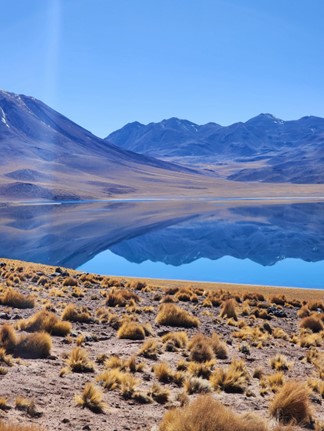 to see just how big one lithium pool was in person; the picture below does not do it justice. We, as humans, extract a myriad of things from the Earth such as minerals, plants, animals and more. All of these resources that we extract contribute to the progression of society, especially minerals like lithium which is considered the “mineral of the future”. However, it is important that we are reminded of Earth’s magnificent creatures and sights that almost cannot be described with words to explain their beauty. We must do more to make sure that these sights don’t disappear. Visiting the lithium mines made me feel as though we as a society, at least in the United States, are far removed from the process of production. This allows us to forget our environmental impact. For example, I did not personally drill for brine containing lithium, but I bought my phone, iPad, and laptop which all contain lithium, and as I bought them, I did not think about the labor and resources that went into producing these items. This needs to change. Visiting the Atacama Desert increased my desire for change within larger corporations and the production of minerals. We need to look for sustainable ways to support people and the Earth, and we need to be knowledgeable about the production of the goods that are so readily available to us.
to see just how big one lithium pool was in person; the picture below does not do it justice. We, as humans, extract a myriad of things from the Earth such as minerals, plants, animals and more. All of these resources that we extract contribute to the progression of society, especially minerals like lithium which is considered the “mineral of the future”. However, it is important that we are reminded of Earth’s magnificent creatures and sights that almost cannot be described with words to explain their beauty. We must do more to make sure that these sights don’t disappear. Visiting the lithium mines made me feel as though we as a society, at least in the United States, are far removed from the process of production. This allows us to forget our environmental impact. For example, I did not personally drill for brine containing lithium, but I bought my phone, iPad, and laptop which all contain lithium, and as I bought them, I did not think about the labor and resources that went into producing these items. This needs to change. Visiting the Atacama Desert increased my desire for change within larger corporations and the production of minerals. We need to look for sustainable ways to support people and the Earth, and we need to be knowledgeable about the production of the goods that are so readily available to us.
 One of the reasons I applied for a GET was to learn about what it might mean to study environmental sociology. Going to Chile taught me one of the ways in which society interacts with the environment. I was eager to hear about the mining process, the increasing need for minerals, and how people view the mining process especially since mining makes up a large portion of Chile’s GDP. After Chile, I want to learn more about environmental sociology and incorporate more about sustainability into my learning. Prior to this trip, much of my study of sociology was spent learning about the social constructions of race, class, gender, and sexuality; I hope to study more about how society interacts with biodiversity, climate change and other environmental topics. Additionally, I think it will be interesting to learn more about the intersectionality of the previously named social constructs and the environment. Lastly, I hope to hear more about sustainability practices like the ones that Anglo American, a global mining company, participates in such as buying land to restore biodiversity.
One of the reasons I applied for a GET was to learn about what it might mean to study environmental sociology. Going to Chile taught me one of the ways in which society interacts with the environment. I was eager to hear about the mining process, the increasing need for minerals, and how people view the mining process especially since mining makes up a large portion of Chile’s GDP. After Chile, I want to learn more about environmental sociology and incorporate more about sustainability into my learning. Prior to this trip, much of my study of sociology was spent learning about the social constructions of race, class, gender, and sexuality; I hope to study more about how society interacts with biodiversity, climate change and other environmental topics. Additionally, I think it will be interesting to learn more about the intersectionality of the previously named social constructs and the environment. Lastly, I hope to hear more about sustainability practices like the ones that Anglo American, a global mining company, participates in such as buying land to restore biodiversity.
Looking Back, Moving Forward
We asked each Trek participant to share their favorite photo from the trip, and a brief description of what it meant to them. Mouse over each photo to learn more.
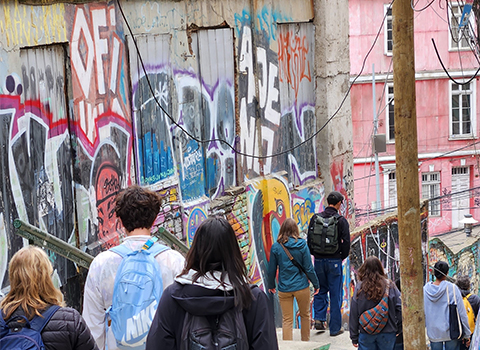












 Nonetheless, something we learned is just as the ore is not the only thing being used at the mine, it is not the only focus of the mines and the mining industry. The processes there generate and have generated a lot of waste, and so there has been a lot of efforts both at Montana Resources and the Anaconda site to come up to code with environmental regulations. At Montana Resources, the Berkeley Pit, where they previously mined, has a very creative way to keep migratory birds off the water–noisemakers! Beyond that, at the Anaconda site, we also saw a lot of completed environmental remediation. The smelting site previously had put heavy metal contamination into the soil, brought sickness to the people nearby, and devastated the local ecology. Now, a large lake with fish, ducks, and birds sit on the previous site where waste was disposed, keeping it trapped underground. The river nearby has been brought back to its glory, and a golf course and trail has been set up on the historic site to bring jobs and commerce to the town. In the tall smoke stack that looks into the sun, the dark black slag (glassy metallic remains from the process of smelting the ore) that lines the golf course, and the informational postings around the Anaconda trails, the town appreciates and remembers its history, but is now coming into a healthier and more environmentally-friendly era.
Nonetheless, something we learned is just as the ore is not the only thing being used at the mine, it is not the only focus of the mines and the mining industry. The processes there generate and have generated a lot of waste, and so there has been a lot of efforts both at Montana Resources and the Anaconda site to come up to code with environmental regulations. At Montana Resources, the Berkeley Pit, where they previously mined, has a very creative way to keep migratory birds off the water–noisemakers! Beyond that, at the Anaconda site, we also saw a lot of completed environmental remediation. The smelting site previously had put heavy metal contamination into the soil, brought sickness to the people nearby, and devastated the local ecology. Now, a large lake with fish, ducks, and birds sit on the previous site where waste was disposed, keeping it trapped underground. The river nearby has been brought back to its glory, and a golf course and trail has been set up on the historic site to bring jobs and commerce to the town. In the tall smoke stack that looks into the sun, the dark black slag (glassy metallic remains from the process of smelting the ore) that lines the golf course, and the informational postings around the Anaconda trails, the town appreciates and remembers its history, but is now coming into a healthier and more environmentally-friendly era.









 After hustling on the descent to escape the mosquitos (futile), we dipped our feet in the ice-cold water of Chena River then headed back to our North Pole cabin for lunch. We then headed to the Midnight Sun Festival. Though it was about 5:00 PM, the sun was still shining overhead as bright as ever. Another notable feature was the general haziness in the air. This orange-tinged gleam was caused by smoke from the wildfires around Fairbanks and in larger interior Alaska. Though it sounds concerning, especially in a state that is known for glaciers and snow, wildfires are actually a natural part of the Alaskan landscape, and very important to the ecological system. Wildfires clear away the
After hustling on the descent to escape the mosquitos (futile), we dipped our feet in the ice-cold water of Chena River then headed back to our North Pole cabin for lunch. We then headed to the Midnight Sun Festival. Though it was about 5:00 PM, the sun was still shining overhead as bright as ever. Another notable feature was the general haziness in the air. This orange-tinged gleam was caused by smoke from the wildfires around Fairbanks and in larger interior Alaska. Though it sounds concerning, especially in a state that is known for glaciers and snow, wildfires are actually a natural part of the Alaskan landscape, and very important to the ecological system. Wildfires clear away the  layer of dead and decaying plants and animals, releasing nutrients from that organic matter back into the soil faster than decomposition, opens space for new or small plants to grow, and allows organisms on land or within the soil to access nutrients. Wildfires happen more in the summer due to increased daylight, which dries out plants and therefore provides fires with their ideal fuel, and hotter temperatures, which leads to more atmospheric instability, which in turn causes the thunderstorms and lightning that ignite these wildfires. Tens of thousands of lightning strikes had caused more than 150 documented wildfires all throughout the state so far, including several large ones near Fairbanks. Though wildfires are natural and normal, their size and the frequency and duration of which they happen have been increasing in the recent decades–especially given that Alaska is warming twice as fast compared to the lower 48.
layer of dead and decaying plants and animals, releasing nutrients from that organic matter back into the soil faster than decomposition, opens space for new or small plants to grow, and allows organisms on land or within the soil to access nutrients. Wildfires happen more in the summer due to increased daylight, which dries out plants and therefore provides fires with their ideal fuel, and hotter temperatures, which leads to more atmospheric instability, which in turn causes the thunderstorms and lightning that ignite these wildfires. Tens of thousands of lightning strikes had caused more than 150 documented wildfires all throughout the state so far, including several large ones near Fairbanks. Though wildfires are natural and normal, their size and the frequency and duration of which they happen have been increasing in the recent decades–especially given that Alaska is warming twice as fast compared to the lower 48.
 Thanks to the blackout curtains in the cabins, we managed a solid three hours of sleep before our flight to Juneau. After a brief layover in Anchorage, we arrived in Juneau International Airport, where mountain views–McGinnis and Stroller White–promptly greeted us through the airport windows. Sorry, O’Hare, you’ve been outclassed.
Thanks to the blackout curtains in the cabins, we managed a solid three hours of sleep before our flight to Juneau. After a brief layover in Anchorage, we arrived in Juneau International Airport, where mountain views–McGinnis and Stroller White–promptly greeted us through the airport windows. Sorry, O’Hare, you’ve been outclassed.

 On Monday, June 23rd the group hopped on a ferry boat early in the morning to head to the Greens Creek Silver Mine outside of Juneau on Admiralty Island. The group enjoyed the stunning mountain view’s and the chill from the ocean, which was much appreciated after experiencing Alaska’s first heat advisory in full fledge. While most of the crew members stayed in the shelter of the cabin, it was interesting to experience the commute of the employees.
On Monday, June 23rd the group hopped on a ferry boat early in the morning to head to the Greens Creek Silver Mine outside of Juneau on Admiralty Island. The group enjoyed the stunning mountain view’s and the chill from the ocean, which was much appreciated after experiencing Alaska’s first heat advisory in full fledge. While most of the crew members stayed in the shelter of the cabin, it was interesting to experience the commute of the employees. Afterwards, we got to the above ground vehicle maintenance area. We then headed over to the Waste Water Treatment Facility, where we learned about the way the metals and sediment are extracted from the water both chemically and physically. We not only got to see the vats where the process takes place, but also the computer system used to monitor each part of the system to ensure the process is running correctly and efficiently. Finally we were able to learn about the processes used to ensure no contamination takes place from the tailings, using soil coverings, linings, external sources and more.
Afterwards, we got to the above ground vehicle maintenance area. We then headed over to the Waste Water Treatment Facility, where we learned about the way the metals and sediment are extracted from the water both chemically and physically. We not only got to see the vats where the process takes place, but also the computer system used to monitor each part of the system to ensure the process is running correctly and efficiently. Finally we were able to learn about the processes used to ensure no contamination takes place from the tailings, using soil coverings, linings, external sources and more.





 After a blissful eight hour and fifteen minute flight (blissful for me, seeing as I slept the whole time — others were not so lucky), we arrived in Santiago at the crack of dawn. After passing through immigration and gathering our things, we went straight to our hotel. However, there is no rest for the wicked, so we dropped our bags off in our rooms and pretty much immediately set off for Pontificia Universidad Católica via Santiago’s metro station.
After a blissful eight hour and fifteen minute flight (blissful for me, seeing as I slept the whole time — others were not so lucky), we arrived in Santiago at the crack of dawn. After passing through immigration and gathering our things, we went straight to our hotel. However, there is no rest for the wicked, so we dropped our bags off in our rooms and pretty much immediately set off for Pontificia Universidad Católica via Santiago’s metro station.  Following our visit at the university, we had the opportunity to visit the AngloAmerican Chile corporate offices, located on the 47th floor of a very fancy skyscraper. There, we were received by Rafael Ascanio, who works on biodiversity assessment, and Gabriella Fuenzalida. They gave us an overview of copper mining, the company, and its sustainability initiatives. The presentation was fascinating. During the presentation, Sr. Fuenzalida said, “We have to do it (mining critical minerals), and we have to do it right.” I think this point of view is critical as we move forward with the energy transition: the acknowledgement that, until we determine some sort of alternative, mining operations such as the ones we are exploring in Chile are imperative and must exist, but they do not have to perpetuate the exploitative socio-ecological history of the industry.
Following our visit at the university, we had the opportunity to visit the AngloAmerican Chile corporate offices, located on the 47th floor of a very fancy skyscraper. There, we were received by Rafael Ascanio, who works on biodiversity assessment, and Gabriella Fuenzalida. They gave us an overview of copper mining, the company, and its sustainability initiatives. The presentation was fascinating. During the presentation, Sr. Fuenzalida said, “We have to do it (mining critical minerals), and we have to do it right.” I think this point of view is critical as we move forward with the energy transition: the acknowledgement that, until we determine some sort of alternative, mining operations such as the ones we are exploring in Chile are imperative and must exist, but they do not have to perpetuate the exploitative socio-ecological history of the industry. 

 On day two, the trek crew flew from Santiago to Calama to tour Codelco's Chuquicamata copper mine. Chuquicamata lies about 20 km outside the city of Calama and produces a steady supply of low-grade ore that predominantly originates from a sulfide and oxide ore body. Chuquicamata began as an open pit mine but is currently being adapted into an underground mine which will employ a block caving mining method to extract ore. The mine is operated by Chile's national mining company, Codelco, who nationalized the mine in 1971 and took it over from an American mining company, the Anaconda Copper Mining Co. Since taking over, Codelco has continued to adapt to new mining technologies and is now using AI to improve their safety record, among other innovations. Chuquicamata mine has been in operation since 1915, when the pit mine was opened, and has continued to grow and continue to produce since. This has resulted in Chuquicamata being one of the largest copper mines in the world, and one of the top producers as well. The tour included an overview of the mining operations such as a view of the pit, a walk through the concentrator plant, and a journey through the refinery. Witnessing each aspect of the process was equally as impressive as the views from the open pit. At the end of the tour, the crew hopped into a van and drove about an hour and a half to the town of San Pedro, where the next mine tour will take place.
On day two, the trek crew flew from Santiago to Calama to tour Codelco's Chuquicamata copper mine. Chuquicamata lies about 20 km outside the city of Calama and produces a steady supply of low-grade ore that predominantly originates from a sulfide and oxide ore body. Chuquicamata began as an open pit mine but is currently being adapted into an underground mine which will employ a block caving mining method to extract ore. The mine is operated by Chile's national mining company, Codelco, who nationalized the mine in 1971 and took it over from an American mining company, the Anaconda Copper Mining Co. Since taking over, Codelco has continued to adapt to new mining technologies and is now using AI to improve their safety record, among other innovations. Chuquicamata mine has been in operation since 1915, when the pit mine was opened, and has continued to grow and continue to produce since. This has resulted in Chuquicamata being one of the largest copper mines in the world, and one of the top producers as well. The tour included an overview of the mining operations such as a view of the pit, a walk through the concentrator plant, and a journey through the refinery. Witnessing each aspect of the process was equally as impressive as the views from the open pit. At the end of the tour, the crew hopped into a van and drove about an hour and a half to the town of San Pedro, where the next mine tour will take place.


 After arriving in San Pedro de Atacama and getting a much needed full night of rest, we woke up and ate breakfast prepared by the hostel. It was today that we would have our long anticipated trip to the Salar de Atacama SQM Lithium extraction facility. The trip to SQM was about two hours long. On arrival, we were greeted by SQM staff and a beautifully prepared spread of snacks.
After arriving in San Pedro de Atacama and getting a much needed full night of rest, we woke up and ate breakfast prepared by the hostel. It was today that we would have our long anticipated trip to the Salar de Atacama SQM Lithium extraction facility. The trip to SQM was about two hours long. On arrival, we were greeted by SQM staff and a beautifully prepared spread of snacks.  After learning about the general operations process of the facility, we went out to see the lithium pools first hand. Perhaps what stood out almost immediately, and even more than the pools themselves, was the mounds of waste piled up across the facility land. This “waste” is all of the non-valuable salts. It was essentially a land of rolling giant table-salt hills. These salts being an essentially useless by-product of the lithium extraction process left many of us with questions of how we can make those salts useful. We’re still not sure.
After learning about the general operations process of the facility, we went out to see the lithium pools first hand. Perhaps what stood out almost immediately, and even more than the pools themselves, was the mounds of waste piled up across the facility land. This “waste” is all of the non-valuable salts. It was essentially a land of rolling giant table-salt hills. These salts being an essentially useless by-product of the lithium extraction process left many of us with questions of how we can make those salts useful. We’re still not sure.  We finished the tour at a viewpoint where we could see the lithium pools in all their glory. From right to left, low-concentration to high-concentration, the pools change color gradually from a turquoise blue to yellow. It was something that I’m sure all of us will remember when we look around and see all of the lithium reliant technology we use our daily lives.
We finished the tour at a viewpoint where we could see the lithium pools in all their glory. From right to left, low-concentration to high-concentration, the pools change color gradually from a turquoise blue to yellow. It was something that I’m sure all of us will remember when we look around and see all of the lithium reliant technology we use our daily lives. 
 On Friday, September 13th, we started the day early to go on a desert ecosystems tour in the Atacama Desert. At 6 am we were picked up at our hostel in San Pedro de Atacama by our tour guide, Ernesto. After picking up a few other tourists, we headed to Laguna Chaxa. This laguna is very special because it's home to three different types of flamingoes: the Andean flamingo, which has a black tail; the Chilean flamingo; and the James flamingo, which is a little smaller. The lithium mine that we had seen the previous day was mentioned because the pumping of the brine from the ground is thought to be affecting the groundwater levels in the area and the lagoon is quickly losing water, affecting the migration of the flamingoes. We got there at sunrise and it was absolutely breathtaking (along with the wind chill). We then went to the Tropic of Capricorn to stop for breakfast. Ernesto and Sammy (our student guide) then made us an amazing breakfast spread with breakfast sandwiches and coffee. We then started our journey up into the Andes to see more lagoons, Miscanti and Miñiques, and volcanoes in the park. We stopped at the two lagunas under the view of the active volcanoes in the area. Then we took off for Piedras Rojas. At this point, some of us were feeling the affects of being at 14,000 feet and we walked slowly out to the Red Rocks Lagoon. The wind was VERY strong and so we stayed long enough to take pictures and enjoy the view and then we walked back. After we piled back in the van, we went to a place put of the wind for lunch, which consisted of a great salad and dessert. We then headed back to San Pedro de Atacama. Once we had rested and showered at the hostel, we headed for dinner at a French cafe nearby and ended the night by walking around the town a little more.
On Friday, September 13th, we started the day early to go on a desert ecosystems tour in the Atacama Desert. At 6 am we were picked up at our hostel in San Pedro de Atacama by our tour guide, Ernesto. After picking up a few other tourists, we headed to Laguna Chaxa. This laguna is very special because it's home to three different types of flamingoes: the Andean flamingo, which has a black tail; the Chilean flamingo; and the James flamingo, which is a little smaller. The lithium mine that we had seen the previous day was mentioned because the pumping of the brine from the ground is thought to be affecting the groundwater levels in the area and the lagoon is quickly losing water, affecting the migration of the flamingoes. We got there at sunrise and it was absolutely breathtaking (along with the wind chill). We then went to the Tropic of Capricorn to stop for breakfast. Ernesto and Sammy (our student guide) then made us an amazing breakfast spread with breakfast sandwiches and coffee. We then started our journey up into the Andes to see more lagoons, Miscanti and Miñiques, and volcanoes in the park. We stopped at the two lagunas under the view of the active volcanoes in the area. Then we took off for Piedras Rojas. At this point, some of us were feeling the affects of being at 14,000 feet and we walked slowly out to the Red Rocks Lagoon. The wind was VERY strong and so we stayed long enough to take pictures and enjoy the view and then we walked back. After we piled back in the van, we went to a place put of the wind for lunch, which consisted of a great salad and dessert. We then headed back to San Pedro de Atacama. Once we had rested and showered at the hostel, we headed for dinner at a French cafe nearby and ended the night by walking around the town a little more.















 This mine is unique because of its smaller size and newer management system. Manto Verde developed in 1960 in the Antofagasta region, but in 2015 was primarily taken over by Capstone Copper. Francisco, the HR manager of the site, welcomed us and we watched a brief safety video on the site before heading to lunch! It was a cool experience to eat with the mining workers and experience a part of their day-to-day life. On our walk around we got to see the emphasis the management team has put on quality of worker life with the fútbol and multipurpose fields. There are even plans to build a movie theater for weekly activities!
This mine is unique because of its smaller size and newer management system. Manto Verde developed in 1960 in the Antofagasta region, but in 2015 was primarily taken over by Capstone Copper. Francisco, the HR manager of the site, welcomed us and we watched a brief safety video on the site before heading to lunch! It was a cool experience to eat with the mining workers and experience a part of their day-to-day life. On our walk around we got to see the emphasis the management team has put on quality of worker life with the fútbol and multipurpose fields. There are even plans to build a movie theater for weekly activities! Because of the delays earlier in the day, we had a shortened tour but still got to see a lot. First we visited one of their four open pit mines. They explained their strategy of blasting weekly, as well as the roughly two months it took per layer. The size of the pit was astounding for only being started in January. Next, we got a nice view of the site from a lookout point, and then moved on to tour the operations control room for their sulfide plant. This facility was recently installed, and overall the focus is on optimizing copper production. Before the site could only treat oxides in the SX-EW plant, but now they have the capability of treating sulfides to ship out copper concentrates. It got a little chilly at one point, but overall a sunny site tour!
Because of the delays earlier in the day, we had a shortened tour but still got to see a lot. First we visited one of their four open pit mines. They explained their strategy of blasting weekly, as well as the roughly two months it took per layer. The size of the pit was astounding for only being started in January. Next, we got a nice view of the site from a lookout point, and then moved on to tour the operations control room for their sulfide plant. This facility was recently installed, and overall the focus is on optimizing copper production. Before the site could only treat oxides in the SX-EW plant, but now they have the capability of treating sulfides to ship out copper concentrates. It got a little chilly at one point, but overall a sunny site tour!








 Today, the group went to a traditional Fonda to enjoy the lively festivities of "La Semana de la Chilenidad." This vibrant celebration, which honors Chilean culture and independence, featured a bustling fair filled with typical Chilean food, music, games, and a variety of captivating performances. One of the highlights of the event was the equestrian showcases, where squads from different countries participated in a “Cultural Exchange,” demonstrating both horsemanship and camaraderie. We also had the opportunity to watch traditional Chilean rodeo showcases, which showcased the skill and tradition of the huasos (Chilean cowboys). In addition, there were dynamic dance performances, featuring dances like the Cueca, Chile’s national dance, adding to the festive and cultural atmosphere.
Today, the group went to a traditional Fonda to enjoy the lively festivities of "La Semana de la Chilenidad." This vibrant celebration, which honors Chilean culture and independence, featured a bustling fair filled with typical Chilean food, music, games, and a variety of captivating performances. One of the highlights of the event was the equestrian showcases, where squads from different countries participated in a “Cultural Exchange,” demonstrating both horsemanship and camaraderie. We also had the opportunity to watch traditional Chilean rodeo showcases, which showcased the skill and tradition of the huasos (Chilean cowboys). In addition, there were dynamic dance performances, featuring dances like the Cueca, Chile’s national dance, adding to the festive and cultural atmosphere.






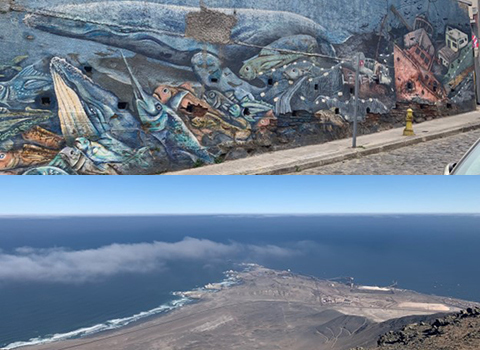
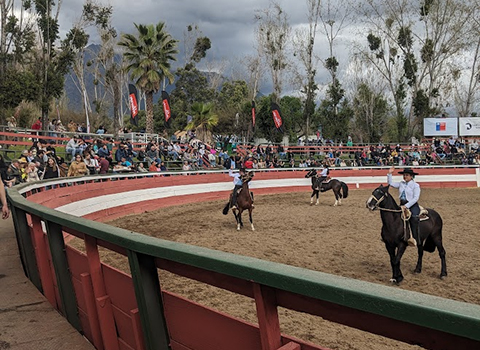
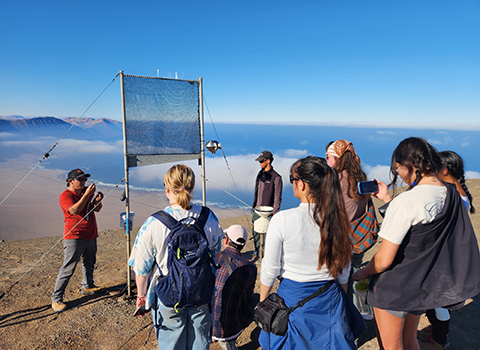





 Today, we had a tour of the Pontificia Universidad Católica de Chile (PUC), led by students from the engineering school. It was exciting for us to meet students our age and experience what university life is like abroad. We strolled around the San Joaquín campus and learned a lot about the university's history, the various programs it offers, and some fun bits about school traditions. Our tour concluded at the Mining Engineering department, where we attended a lecture by Professor Alvaro Videla on sustainable mining strategies in Chile. It was interesting to learn about the growing emphasis on transparency and the development of sustainable solutions within Chilean mining companies. Following the lecture, we enjoyed lunch and had the opportunity to connect with other students in the mining engineering department.
Today, we had a tour of the Pontificia Universidad Católica de Chile (PUC), led by students from the engineering school. It was exciting for us to meet students our age and experience what university life is like abroad. We strolled around the San Joaquín campus and learned a lot about the university's history, the various programs it offers, and some fun bits about school traditions. Our tour concluded at the Mining Engineering department, where we attended a lecture by Professor Alvaro Videla on sustainable mining strategies in Chile. It was interesting to learn about the growing emphasis on transparency and the development of sustainable solutions within Chilean mining companies. Following the lecture, we enjoyed lunch and had the opportunity to connect with other students in the mining engineering department. exploring the campus, our tour guides noticed the sound of cueca music being played by some PUC alumni. They kindly demonstrated how the traditional cueca dance is performed and even invited several students from our group to join in and participate in the dance! This was, by far, my favorite part of the day and one of the most memorable moments from the trip. It was a very spontaneous activity that we just happened to come across, but it was really fun to experience it and learn from the PUC students.
exploring the campus, our tour guides noticed the sound of cueca music being played by some PUC alumni. They kindly demonstrated how the traditional cueca dance is performed and even invited several students from our group to join in and participate in the dance! This was, by far, my favorite part of the day and one of the most memorable moments from the trip. It was a very spontaneous activity that we just happened to come across, but it was really fun to experience it and learn from the PUC students.

 After a late, but exciting night, we woke up early to catch our plane to Calama and San Pedro de Atacama. On the drive to the hostel, we were in awe as we gazed at the incredible view of the mountains. Once we arrived at the Pablito Hostal, we unpacked and prepared for lunch at a cute bakery called Franchuteria. They offered croissants, baguettes, and sandwiches. My personal favorite was a raspberry jelly filled croissant drizzled with white chocolate. Unlike most bakeries, Franchuteria integrated the natural environment with trees surrounding tables which provided a beautiful dining area.
After a late, but exciting night, we woke up early to catch our plane to Calama and San Pedro de Atacama. On the drive to the hostel, we were in awe as we gazed at the incredible view of the mountains. Once we arrived at the Pablito Hostal, we unpacked and prepared for lunch at a cute bakery called Franchuteria. They offered croissants, baguettes, and sandwiches. My personal favorite was a raspberry jelly filled croissant drizzled with white chocolate. Unlike most bakeries, Franchuteria integrated the natural environment with trees surrounding tables which provided a beautiful dining area.


 Our day started with breakfast at the hostel, followed by a van ride south from San Pedro to the SQM lithium production facility. The ride took us through small, sparsely populated towns and desert, most of which we had seen during yesterday’s tour. On the final road leading to the SQM facility, we spotted pipelines which we later learned were freshwater supply lines, and, in the distance, massive piles of what appeared to be stark white sand. We were greeted by Ivonne Toro, a community relations director for SQM, and our tour guide, who gave a presentation on the operations and environmental considerations of the facility while we had refreshments. An extensive Q & A session ensued, including questions about the biological and ecological factors that the company tracks, the water usage and byproduct production of the lithium harvesting process, and the about the company’s relationship with local communities.
Our day started with breakfast at the hostel, followed by a van ride south from San Pedro to the SQM lithium production facility. The ride took us through small, sparsely populated towns and desert, most of which we had seen during yesterday’s tour. On the final road leading to the SQM facility, we spotted pipelines which we later learned were freshwater supply lines, and, in the distance, massive piles of what appeared to be stark white sand. We were greeted by Ivonne Toro, a community relations director for SQM, and our tour guide, who gave a presentation on the operations and environmental considerations of the facility while we had refreshments. An extensive Q & A session ensued, including questions about the biological and ecological factors that the company tracks, the water usage and byproduct production of the lithium harvesting process, and the about the company’s relationship with local communities.

 The second day back from San Pedro we started the day by taking the Metro to the Sustainable Mineral Institute, a research institute through the University of Queensland Brisbane focused on researching and supporting the increasing demand for rare minerals through a lens of sustainability and inclusion of indigenous communities. We met with Doug Aitken, the director of the Chilean branch of SMI and a group of other people who worked there, including a mining engineer, a specialist in biodiversity and forestry, a geology engineer, and several people who worked with indigenous communities affected by mining. People on the team were from Scotland, Belgium, England, and Chile and had a range of different career paths and ages.
The second day back from San Pedro we started the day by taking the Metro to the Sustainable Mineral Institute, a research institute through the University of Queensland Brisbane focused on researching and supporting the increasing demand for rare minerals through a lens of sustainability and inclusion of indigenous communities. We met with Doug Aitken, the director of the Chilean branch of SMI and a group of other people who worked there, including a mining engineer, a specialist in biodiversity and forestry, a geology engineer, and several people who worked with indigenous communities affected by mining. People on the team were from Scotland, Belgium, England, and Chile and had a range of different career paths and ages.  We arrived and put on safety equipment: bright orange jumpsuits, rubber books, helmets, air masks, gloves, and a GPS tracker. Inside the mountain, we started out by seeing the offices where they control some of the equipment remotely from what look like gaming chairs with joysticks and buttons. Our guide joked about an earthquake happening while we were there, but told us that it would actually be safer to be inside the mine than outside of it there was an earthquake.
We arrived and put on safety equipment: bright orange jumpsuits, rubber books, helmets, air masks, gloves, and a GPS tracker. Inside the mountain, we started out by seeing the offices where they control some of the equipment remotely from what look like gaming chairs with joysticks and buttons. Our guide joked about an earthquake happening while we were there, but told us that it would actually be safer to be inside the mine than outside of it there was an earthquake. 


 Today, on our final day in Chile, we kicked off the morning by traveling to some local hand-craft shops. There, we walked around the village of shops and were able to appreciate the beauty of the local artisans’ work. It was very cool to see a mix of cultural and local imagery depicted in a variety of mediums, and I appreciated the opportunity to learn more about the country we were visiting.
Today, on our final day in Chile, we kicked off the morning by traveling to some local hand-craft shops. There, we walked around the village of shops and were able to appreciate the beauty of the local artisans’ work. It was very cool to see a mix of cultural and local imagery depicted in a variety of mediums, and I appreciated the opportunity to learn more about the country we were visiting. that companies take a more active role in environmental stewardship. It seems Anglo American has embraced this reality in full and is determined to set the gold standard for environmental conservation in the mining industry.
that companies take a more active role in environmental stewardship. It seems Anglo American has embraced this reality in full and is determined to set the gold standard for environmental conservation in the mining industry. I went on the Global Engineering Trek (GET) to Chile as a Psychology and Sociology student, and I didn’t know what to expect. I wasn’t sure if applying to go to Chile was meant for me because I am not a McCormick student. But, the choice to take this opportunity was one of my best academic decisions. This trip was my first time traveling abroad, and I got to learn so much more about the world.
I went on the Global Engineering Trek (GET) to Chile as a Psychology and Sociology student, and I didn’t know what to expect. I wasn’t sure if applying to go to Chile was meant for me because I am not a McCormick student. But, the choice to take this opportunity was one of my best academic decisions. This trip was my first time traveling abroad, and I got to learn so much more about the world. to see just how big one lithium pool was in person; the picture below does not do it justice. We, as humans, extract a myriad of things from the Earth such as minerals, plants, animals and more. All of these resources that we extract contribute to the progression of society, especially minerals like lithium which is considered the “mineral of the future”. However, it is important that we are reminded of Earth’s magnificent creatures and sights that almost cannot be described with words to explain their beauty. We must do more to make sure that these sights don’t disappear. Visiting the lithium mines made me feel as though we as a society, at least in the United States, are far removed from the process of production. This allows us to forget our environmental impact. For example, I did not personally drill for brine containing lithium, but I bought my phone, iPad, and laptop which all contain lithium, and as I bought them, I did not think about the labor and resources that went into producing these items. This needs to change. Visiting the Atacama Desert increased my desire for change within larger corporations and the production of minerals. We need to look for sustainable ways to support people and the Earth, and we need to be knowledgeable about the production of the goods that are so readily available to us.
to see just how big one lithium pool was in person; the picture below does not do it justice. We, as humans, extract a myriad of things from the Earth such as minerals, plants, animals and more. All of these resources that we extract contribute to the progression of society, especially minerals like lithium which is considered the “mineral of the future”. However, it is important that we are reminded of Earth’s magnificent creatures and sights that almost cannot be described with words to explain their beauty. We must do more to make sure that these sights don’t disappear. Visiting the lithium mines made me feel as though we as a society, at least in the United States, are far removed from the process of production. This allows us to forget our environmental impact. For example, I did not personally drill for brine containing lithium, but I bought my phone, iPad, and laptop which all contain lithium, and as I bought them, I did not think about the labor and resources that went into producing these items. This needs to change. Visiting the Atacama Desert increased my desire for change within larger corporations and the production of minerals. We need to look for sustainable ways to support people and the Earth, and we need to be knowledgeable about the production of the goods that are so readily available to us. One of the reasons I applied for a GET was to learn about what it might mean to study environmental sociology. Going to Chile taught me one of the ways in which society interacts with the environment. I was eager to hear about the mining process, the increasing need for minerals, and how people view the mining process especially since mining makes up a large portion of Chile’s GDP. After Chile, I want to learn more about environmental sociology and incorporate more about sustainability into my learning. Prior to this trip, much of my study of sociology was spent learning about the social constructions of race, class, gender, and sexuality; I hope to study more about how society interacts with biodiversity, climate change and other environmental topics. Additionally, I think it will be interesting to learn more about the intersectionality of the previously named social constructs and the environment. Lastly, I hope to hear more about sustainability practices like the ones that Anglo American, a global mining company, participates in such as buying land to restore biodiversity.
One of the reasons I applied for a GET was to learn about what it might mean to study environmental sociology. Going to Chile taught me one of the ways in which society interacts with the environment. I was eager to hear about the mining process, the increasing need for minerals, and how people view the mining process especially since mining makes up a large portion of Chile’s GDP. After Chile, I want to learn more about environmental sociology and incorporate more about sustainability into my learning. Prior to this trip, much of my study of sociology was spent learning about the social constructions of race, class, gender, and sexuality; I hope to study more about how society interacts with biodiversity, climate change and other environmental topics. Additionally, I think it will be interesting to learn more about the intersectionality of the previously named social constructs and the environment. Lastly, I hope to hear more about sustainability practices like the ones that Anglo American, a global mining company, participates in such as buying land to restore biodiversity.